EARNINGS PRESENTATION
Published on February 20, 2025

Financial presentation to accompany management commentary FY25 Q4

The following guidance reflects the Company’s expectations for the first quarter and fiscal year 2026 and is provided on a non-GAAP basis as the Company cannot predict certain elements that are included in reported GAAP results, such as the changes in fair value of the Company’s equity and other investments. Growth rates reflect an adjusted basis for prior year results. Additionally, the Company’s guidance assumes a generally stable consumer and continued pressure from its mix of products and formats globally. First quarter The Company’s first quarter fiscal 2026 guidance is based on the following Q1 FY25 figures: Net Sales: $159.9 billion, adjusted operating income1: $7.1 billion, and adjusted EPS1: $0.60. Consolidated metric Q1 FY26 Net sales (cc) Increase 3.0% to 4.0% • Including approximately 100 bps headwind from lapping leap year • Including approximately 15 bps tailwind from acquisition of VIZIO Adj. operating income (cc) Increase 0.5% to 2.0% • Including approximately 250 bps headwind from lapping leap year • Including approximately 70 bps headwind from acquisition of VIZIO Adjusted EPS $0.57 to $0.58, including approximately $0.02 headwind from currency Fiscal year 2026 The Company’s fiscal year guidance is based on the following FY25 figures: Net sales: $674.5 billion, adjusted operating income2: $29.5 billion, and adjusted EPS2: $2.51. Consolidated metric FY26 Net sales (cc) Increase 3.0% to 4.0% Including approximately 20 bps headwind from lapping leap year Including approximately 20 bps tailwind from acquisition of VIZIO Adj. operating income (cc) Increase 3.5% to 5.5% Including approximately 70 bps headwind from lapping leap year Including approximately 80 bps headwind from acquisition of VIZIO Interest, net Increase approximately $100M to $200M Effective tax rate Approximately 23.5% to 24.5% Non-controlling interest Relatively flat Adjusted EPS $2.50 to $2.60, including approximately $0.05 headwind from currency Capital expenditures Approximately 3.0% to 3.5% of net sales 1 For relevant non-GAAP reconciliations, see Q1 FY25 earnings release furnished on Form 8-K on May 16, 2024. 2 See additional information at the end of this presentation regarding non-GAAP financial measures. cc = constant currency Guidance 2
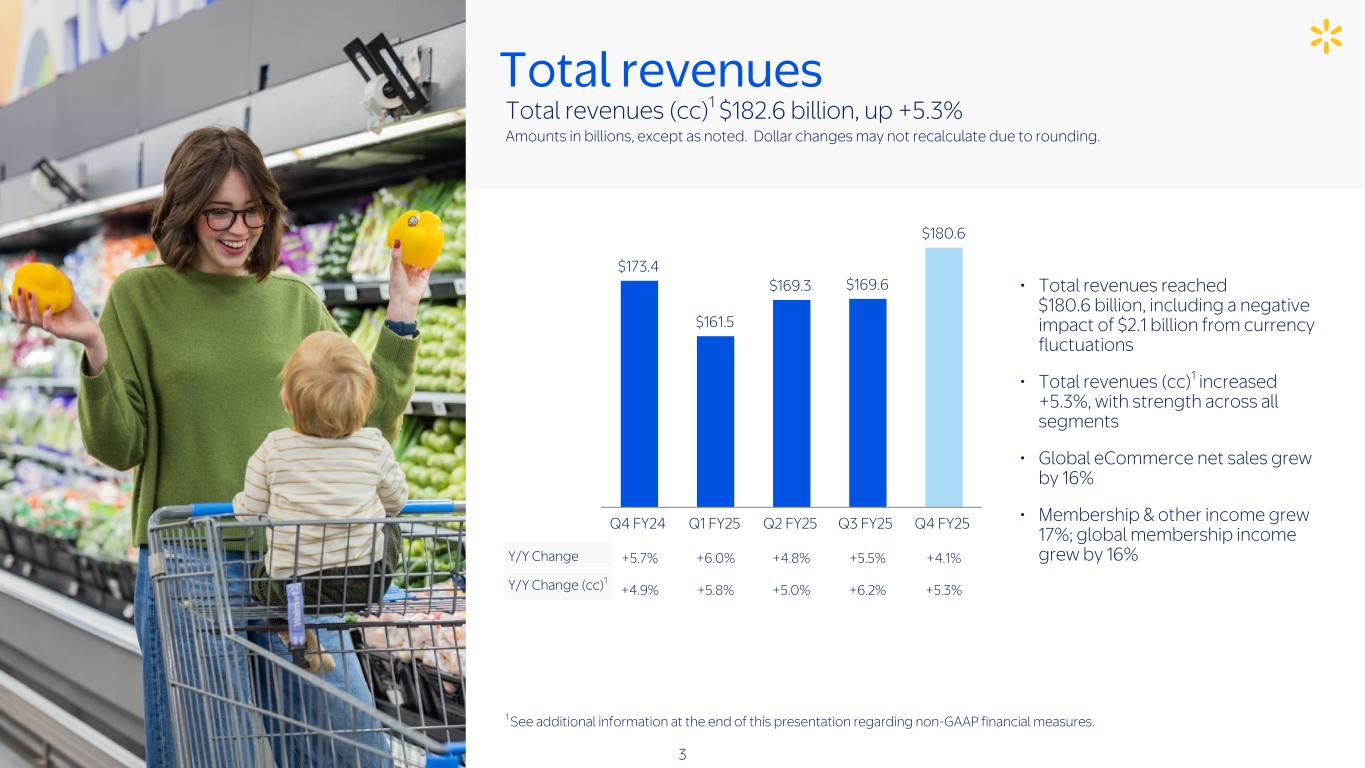
Total revenues (cc)1 $182.6 billion, up +5.3% Amounts in billions, except as noted. Dollar changes may not recalculate due to rounding. • Total revenues reached $180.6 billion, including a negative impact of $2.1 billion from currency fluctuations • Total revenues (cc)1 increased +5.3%, with strength across all segments • Global eCommerce net sales grew by 16% • Membership & other income grew 17%; global membership income grew by 16%Y/Y Change +5.7% +6.0% +4.8% +5.5% +4.1% Y/Y Change (cc)1 +4.9% +5.8% +5.0% +6.2% +5.3% 1 See additional information at the end of this presentation regarding non-GAAP financial measures. Total revenues $173.4 $161.5 $169.3 $169.6 $180.6 Q4 FY24 Q1 FY25 Q2 FY25 Q3 FY25 Q4 FY25 3
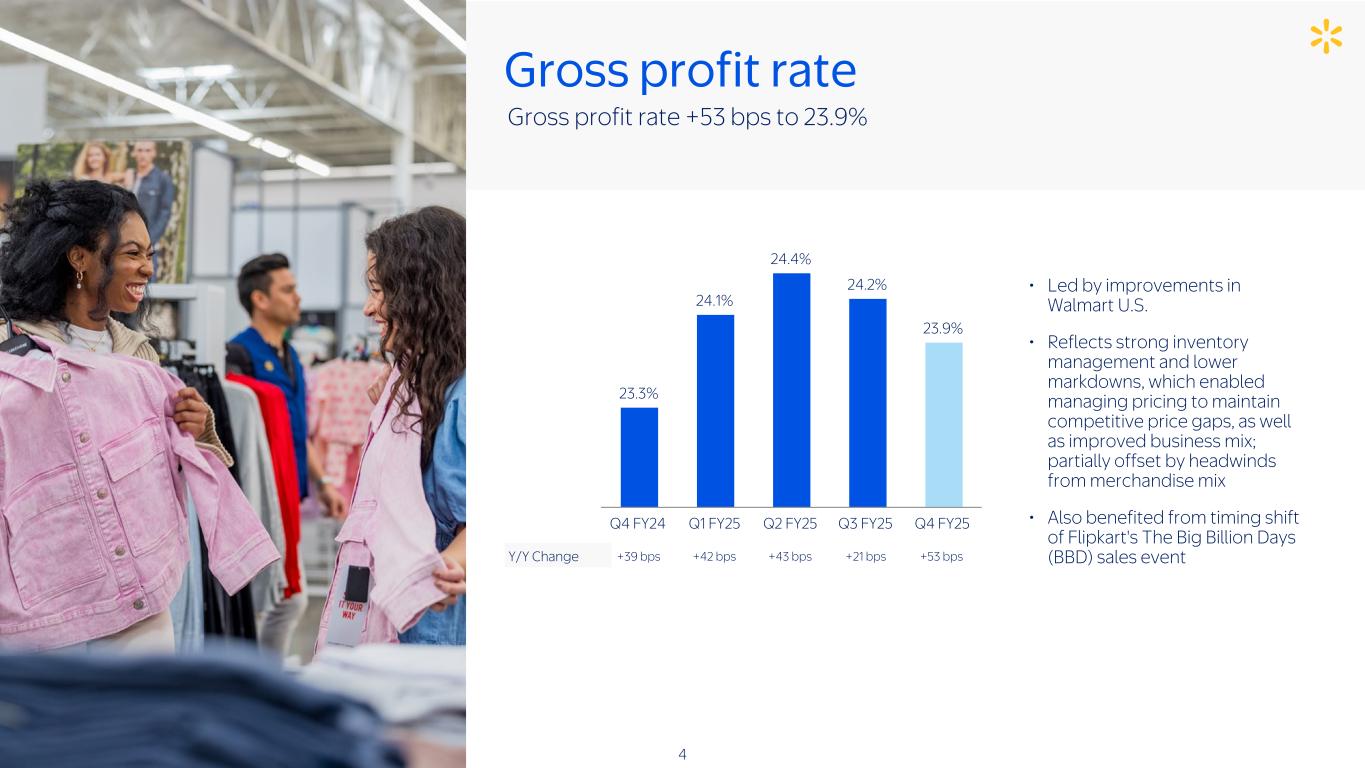
• Led by improvements in Walmart U.S. • Reflects strong inventory management and lower markdowns, which enabled managing pricing to maintain competitive price gaps, as well as improved business mix; partially offset by headwinds from merchandise mix • Also benefited from timing shift of Flipkart's The Big Billion Days (BBD) sales eventY/Y Change +39 bps +42 bps +43 bps +21 bps +53 bps Gross profit rate 23.3% 24.1% 24.4% 24.2% 23.9% Q4 FY24 Q1 FY25 Q2 FY25 Q3 FY25 Q4 FY25 Gross profit rate +53 bps to 23.9% 4
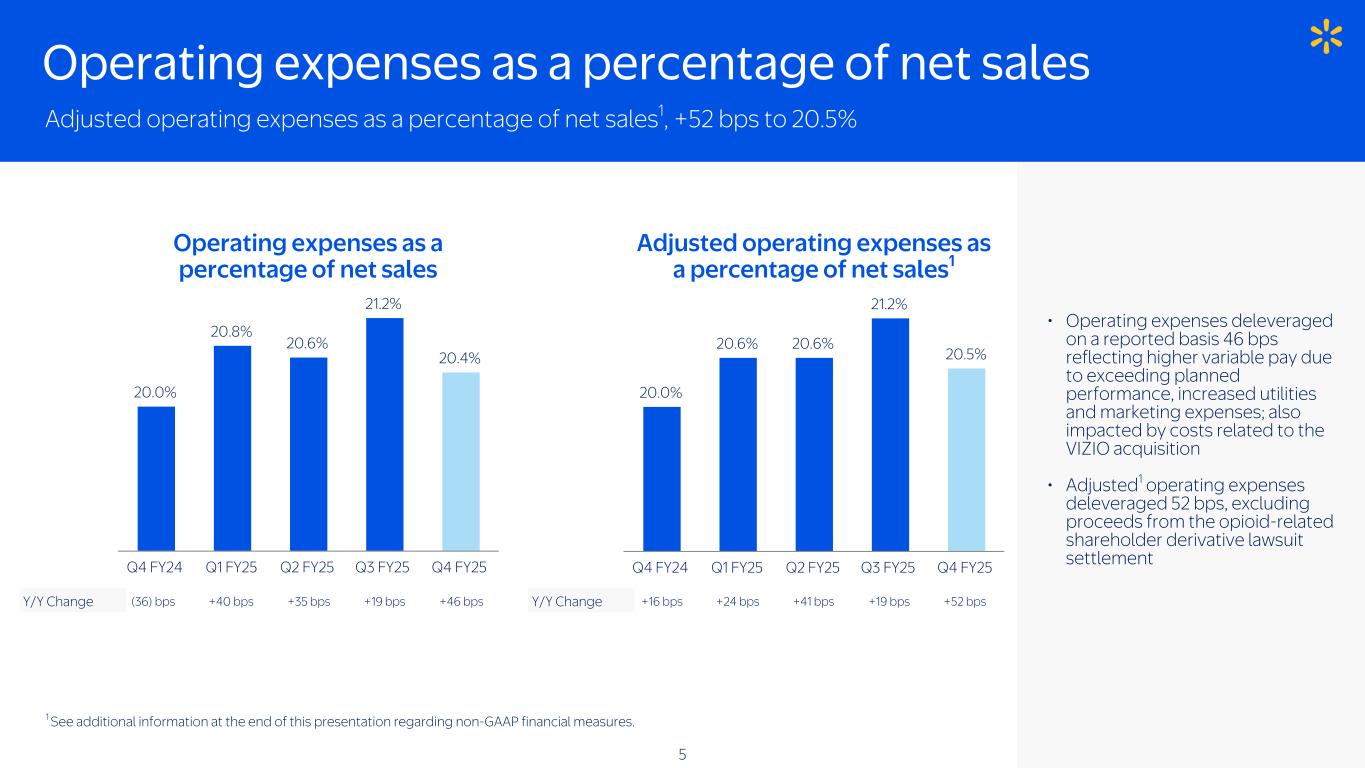
Adjusted operating expenses as a percentage of net sales1, +52 bps to 20.5% • Operating expenses deleveraged on a reported basis 46 bps reflecting higher variable pay due to exceeding planned performance, increased utilities and marketing expenses; also impacted by costs related to the VIZIO acquisition • Adjusted1 operating expenses deleveraged 52 bps, excluding proceeds from the opioid-related shareholder derivative lawsuit settlement Y/Y Change +16 bps +24 bps +41 bps +19 bps +52 bps 20.0% 20.6% 20.6% 21.2% 20.5% Q4 FY24 Q1 FY25 Q2 FY25 Q3 FY25 Q4 FY25 Operating expenses as a percentage of net sales 20.0% 20.8% 20.6% 21.2% 20.4% Q4 FY24 Q1 FY25 Q2 FY25 Q3 FY25 Q4 FY25 Y/Y Change (36) bps +40 bps +35 bps +19 bps +46 bps Operating expenses as a percentage of net sales Adjusted operating expenses as a percentage of net sales1 1 See additional information at the end of this presentation regarding non-GAAP financial measures. 5
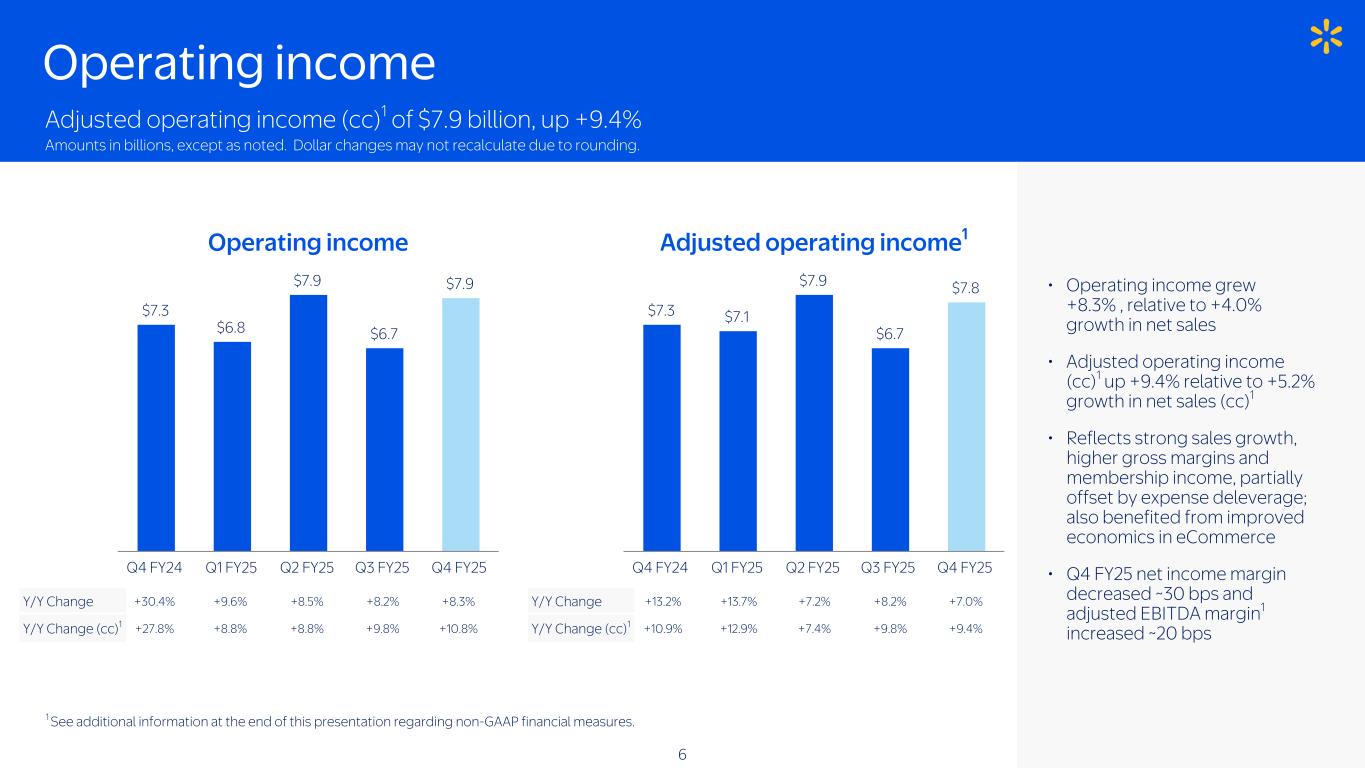
1 See additional information at the end of this presentation regarding non-GAAP financial measures. Operating income • Operating income grew +8.3% , relative to +4.0% growth in net sales • Adjusted operating income (cc)1 up +9.4% relative to +5.2% growth in net sales (cc)1 • Reflects strong sales growth, higher gross margins and membership income, partially offset by expense deleverage; also benefited from improved economics in eCommerce • Q4 FY25 net income margin decreased ~30 bps and adjusted EBITDA margin1 increased ~20 bps Operating income Adjusted operating income1 $7.3 $6.8 $7.9 $6.7 $7.9 Q4 FY24 Q1 FY25 Q2 FY25 Q3 FY25 Q4 FY25 Y/Y Change +13.2% +13.7% +7.2% +8.2% +7.0% Y/Y Change (cc)1 +10.9% +12.9% +7.4% +9.8% +9.4% Y/Y Change +30.4% +9.6% +8.5% +8.2% +8.3% Y/Y Change (cc)1 +27.8% +8.8% +8.8% +9.8% +10.8% $7.3 $7.1 $7.9 $6.7 $7.8 Q4 FY24 Q1 FY25 Q2 FY25 Q3 FY25 Q4 FY25 Adjusted operating income (cc)1 of $7.9 billion, up +9.4% Amounts in billions, except as noted. Dollar changes may not recalculate due to rounding. 6
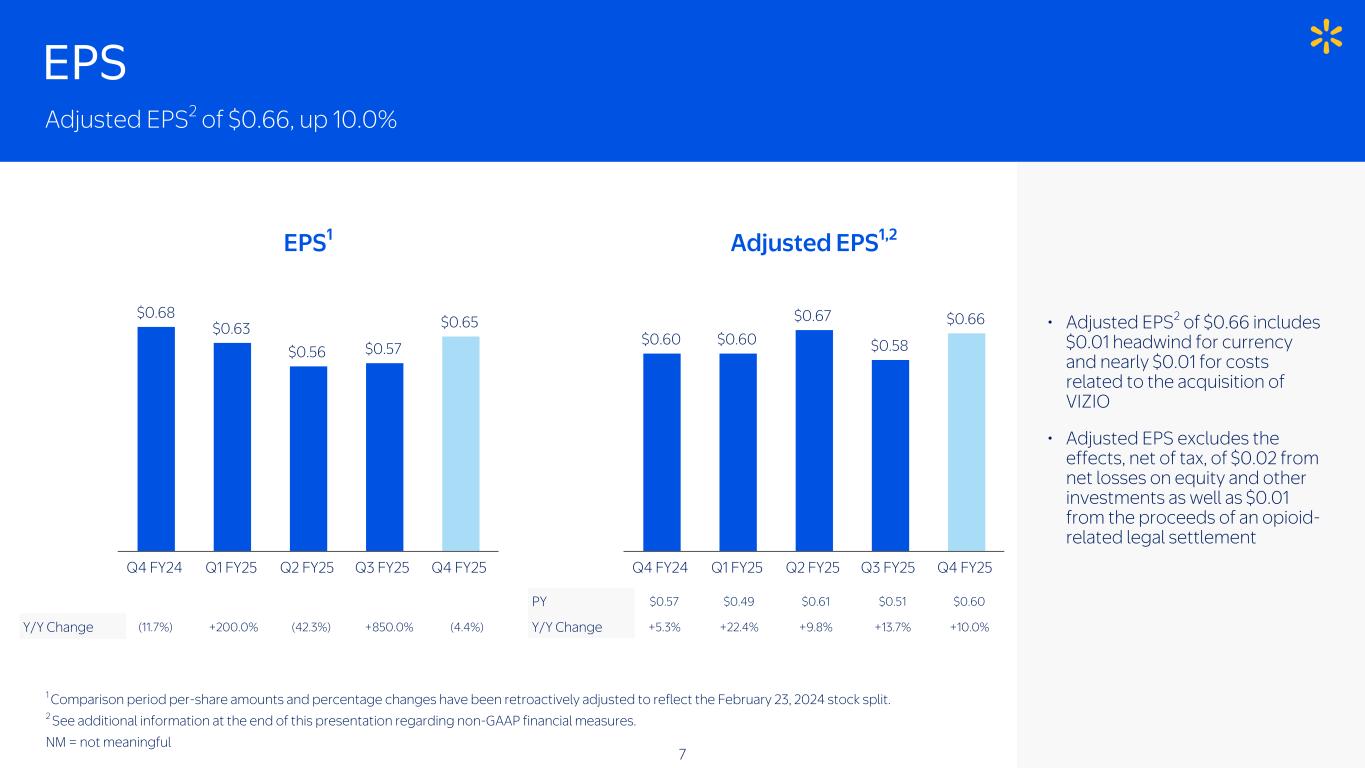
1 Comparison period per-share amounts and percentage changes have been retroactively adjusted to reflect the February 23, 2024 stock split. 2 See additional information at the end of this presentation regarding non-GAAP financial measures. NM = not meaningful Adjusted EPS2 of $0.66, up 10.0% EPS PY $0.57 $0.49 $0.61 $0.51 $0.60 Y/Y Change +5.3% +22.4% +9.8% +13.7% +10.0% • Adjusted EPS2 of $0.66 includes $0.01 headwind for currency and nearly $0.01 for costs related to the acquisition of VIZIO • Adjusted EPS excludes the effects, net of tax, of $0.02 from net losses on equity and other investments as well as $0.01 from the proceeds of an opioid- related legal settlement Y/Y Change (11.7%) +200.0% (42.3%) +850.0% (4.4%) EPS1 $0.60 $0.60 $0.67 $0.58 $0.66 Q4 FY24 Q1 FY25 Q2 FY25 Q3 FY25 Q4 FY25 $0.68 $0.63 $0.56 $0.57 $0.65 Q4 FY24 Q1 FY25 Q2 FY25 Q3 FY25 Q4 FY25 7 Adjusted EPS1,2
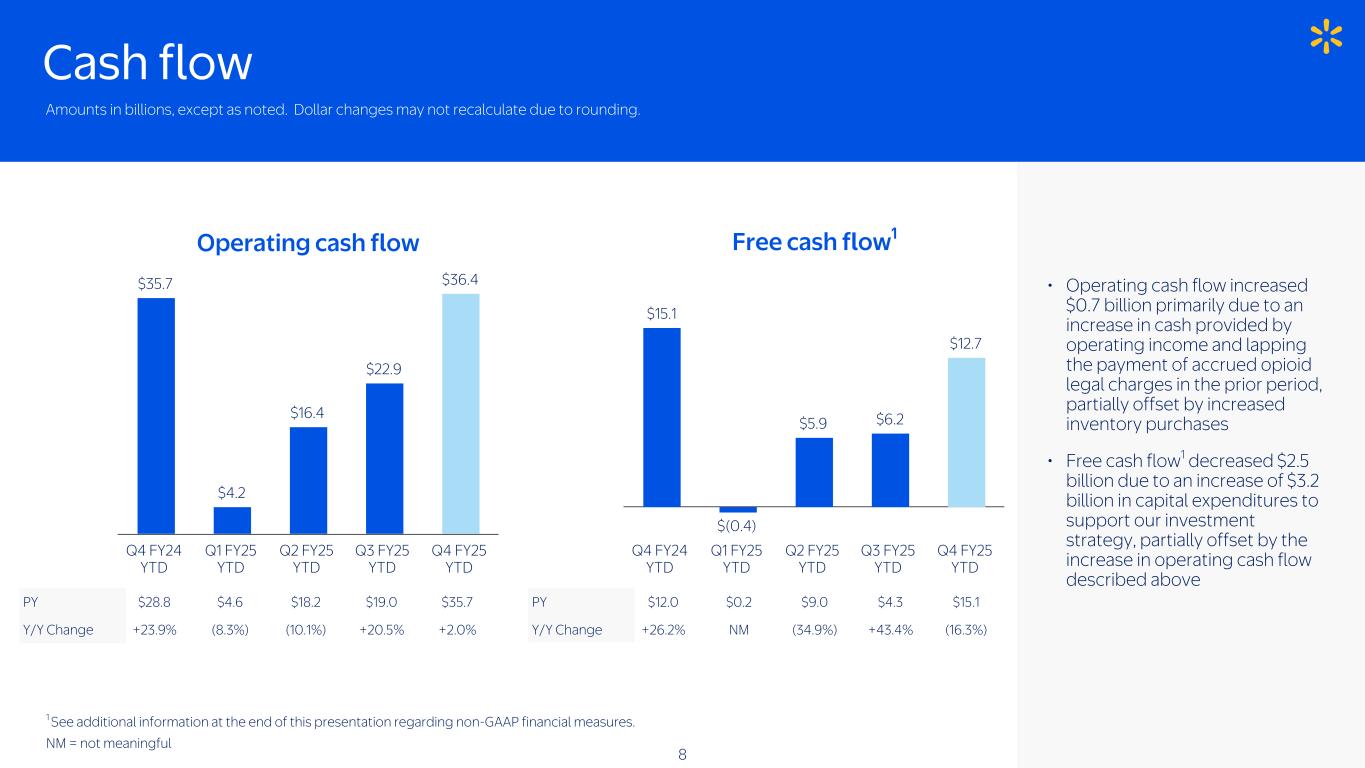
PY $12.0 $0.2 $9.0 $4.3 $15.1 Y/Y Change +26.2% NM (34.9%) +43.4% (16.3%) • Operating cash flow increased $0.7 billion primarily due to an increase in cash provided by operating income and lapping the payment of accrued opioid legal charges in the prior period, partially offset by increased inventory purchases • Free cash flow1 decreased $2.5 billion due to an increase of $3.2 billion in capital expenditures to support our investment strategy, partially offset by the increase in operating cash flow described above 1 See additional information at the end of this presentation regarding non-GAAP financial measures. NM = not meaningful PY $28.8 $4.6 $18.2 $19.0 $35.7 Y/Y Change +23.9% (8.3%) (10.1%) +20.5% +2.0% Operating cash flow Free cash flow1 Cash flow $15.1 $(0.4) $5.9 $6.2 $12.7 Q4 FY24 YTD Q1 FY25 YTD Q2 FY25 YTD Q3 FY25 YTD Q4 FY25 YTD $35.7 $4.2 $16.4 $22.9 $36.4 Q4 FY24 YTD Q1 FY25 YTD Q2 FY25 YTD Q3 FY25 YTD Q4 FY25 YTD Amounts in billions, except as noted. Dollar changes may not recalculate due to rounding. 8
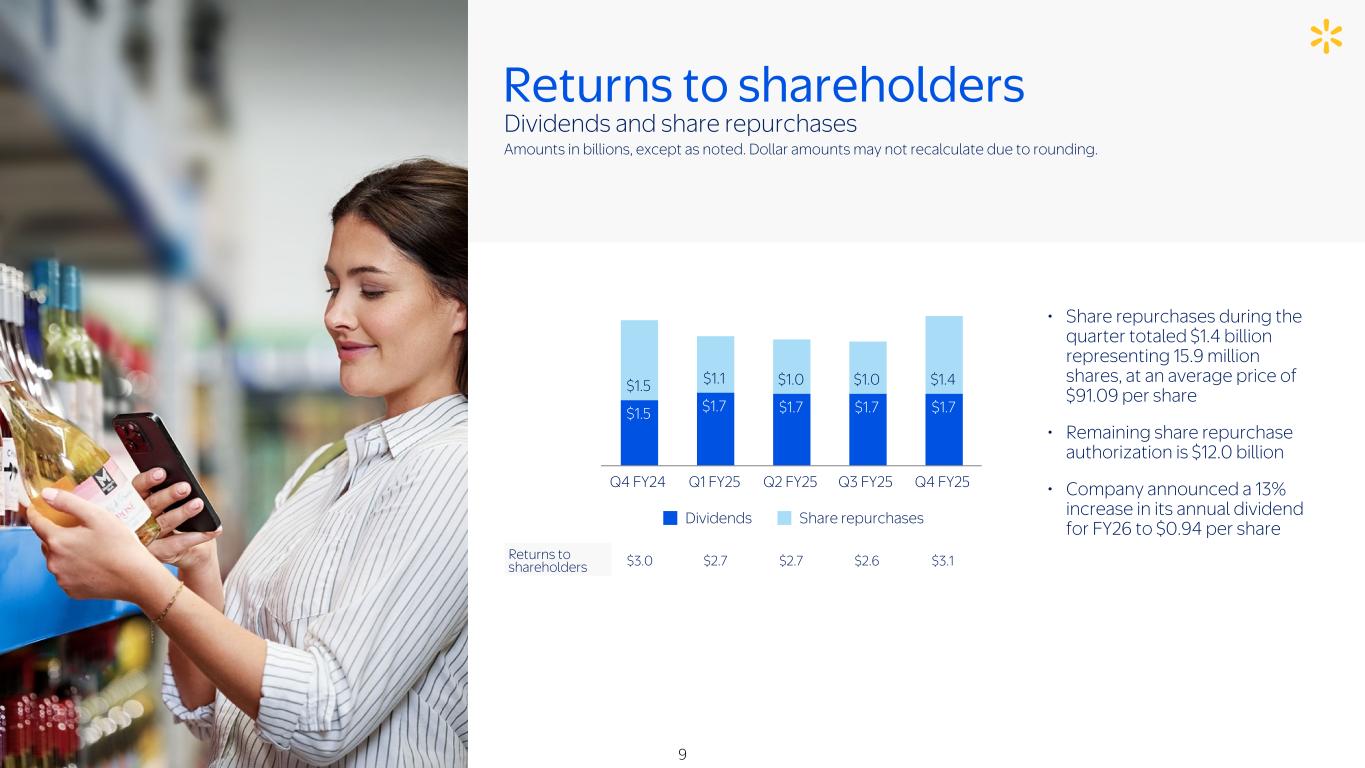
Dividends and share repurchases Amounts in billions, except as noted. Dollar amounts may not recalculate due to rounding. • Share repurchases during the quarter totaled $1.4 billion representing 15.9 million shares, at an average price of $91.09 per share • Remaining share repurchase authorization is $12.0 billion • Company announced a 13% increase in its annual dividend for FY26 to $0.94 per share Returns to shareholders $3.0 $2.7 $2.7 $2.6 $3.1 Returns to shareholders $1.5 $1.7 $1.7 $1.7 $1.7 $1.5 $1.1 $1.0 $1.0 $1.4 Dividends Share repurchases Q4 FY24 Q1 FY25 Q2 FY25 Q3 FY25 Q4 FY25 9
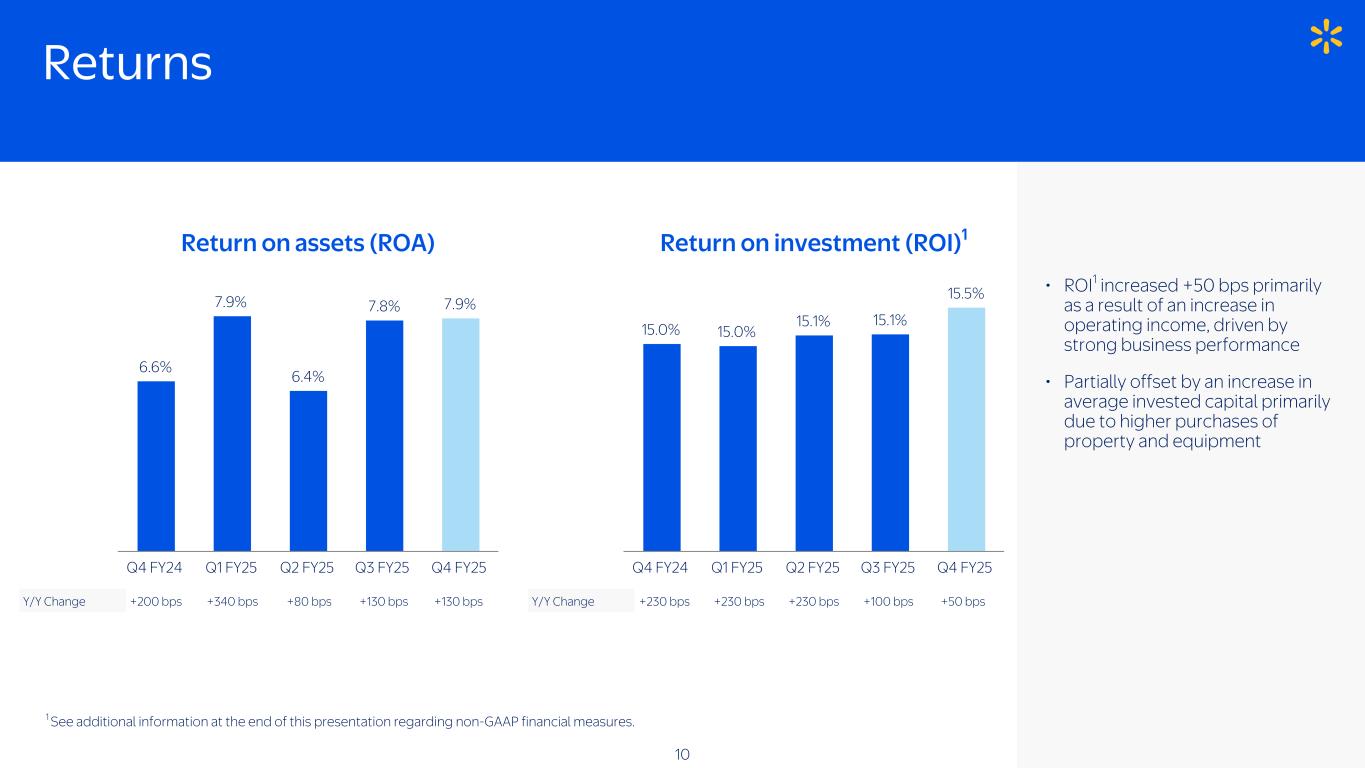
Y/Y Change +230 bps +230 bps +230 bps +100 bps +50 bps • ROI1 increased +50 bps primarily as a result of an increase in operating income, driven by strong business performance • Partially offset by an increase in average invested capital primarily due to higher purchases of property and equipment 1 See additional information at the end of this presentation regarding non-GAAP financial measures. Return on assets (ROA) Return on investment (ROI)1 Returns Y/Y Change +200 bps +340 bps +80 bps +130 bps +130 bps 6.6% 7.9% 6.4% 7.8% 7.9% Q4 FY24 Q1 FY25 Q2 FY25 Q3 FY25 Q4 FY25 15.0% 15.0% 15.1% 15.1% 15.5% Q4 FY24 Q1 FY25 Q2 FY25 Q3 FY25 Q4 FY25 10
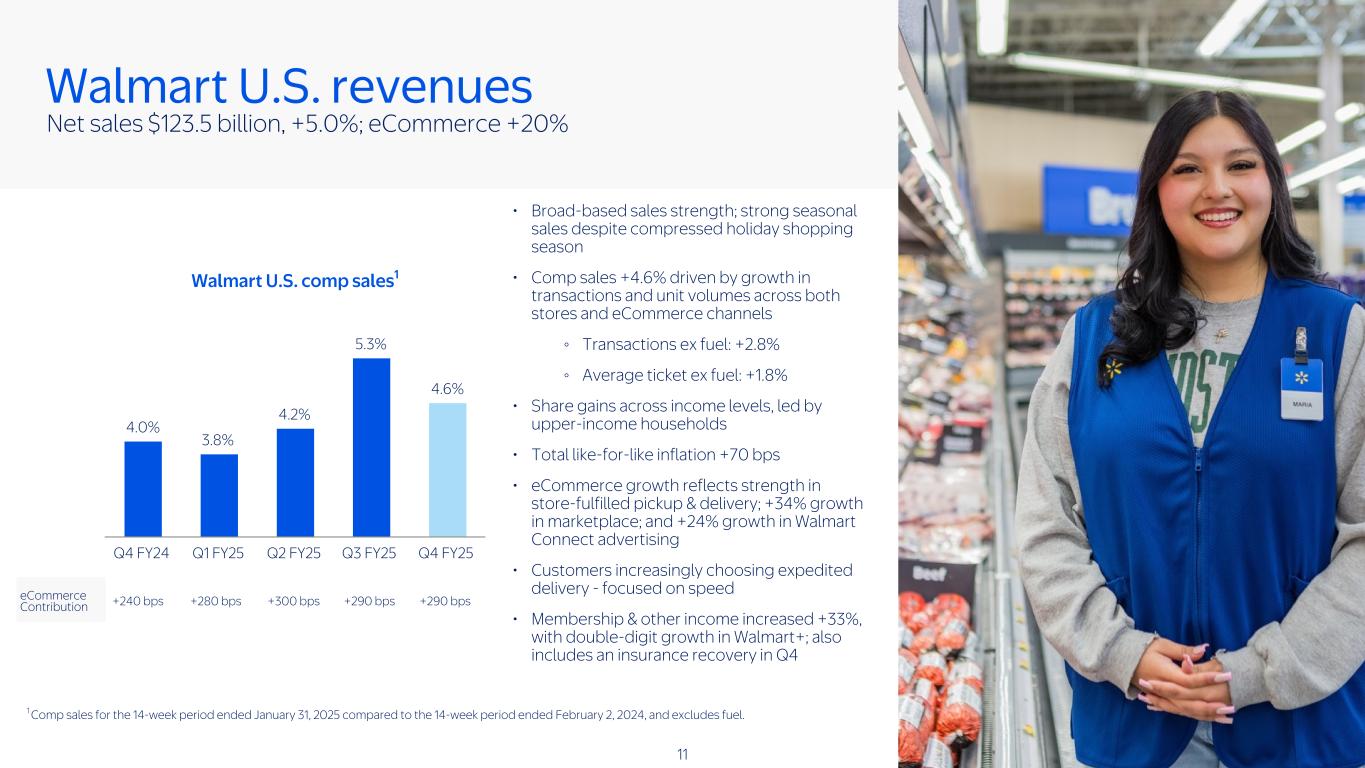
Net sales $123.5 billion, +5.0%; eCommerce +20% • Broad-based sales strength; strong seasonal sales despite compressed holiday shopping season • Comp sales +4.6% driven by growth in transactions and unit volumes across both stores and eCommerce channels ◦ Transactions ex fuel: +2.8% ◦ Average ticket ex fuel: +1.8% • Share gains across income levels, led by upper-income households • Total like-for-like inflation +70 bps • eCommerce growth reflects strength in store-fulfilled pickup & delivery; +34% growth in marketplace; and +24% growth in Walmart Connect advertising • Customers increasingly choosing expedited delivery - focused on speed • Membership & other income increased +33%, with double-digit growth in Walmart+; also includes an insurance recovery in Q4 eCommerce Contribution +240 bps +280 bps +300 bps +290 bps +290 bps Walmart U.S. revenues 4.0% 3.8% 4.2% 5.3% 4.6% Q4 FY24 Q1 FY25 Q2 FY25 Q3 FY25 Q4 FY25 1 Comp sales for the 14-week period ended January 31, 2025 compared to the 14-week period ended February 2, 2024, and excludes fuel. 11 Walmart U.S. comp sales1
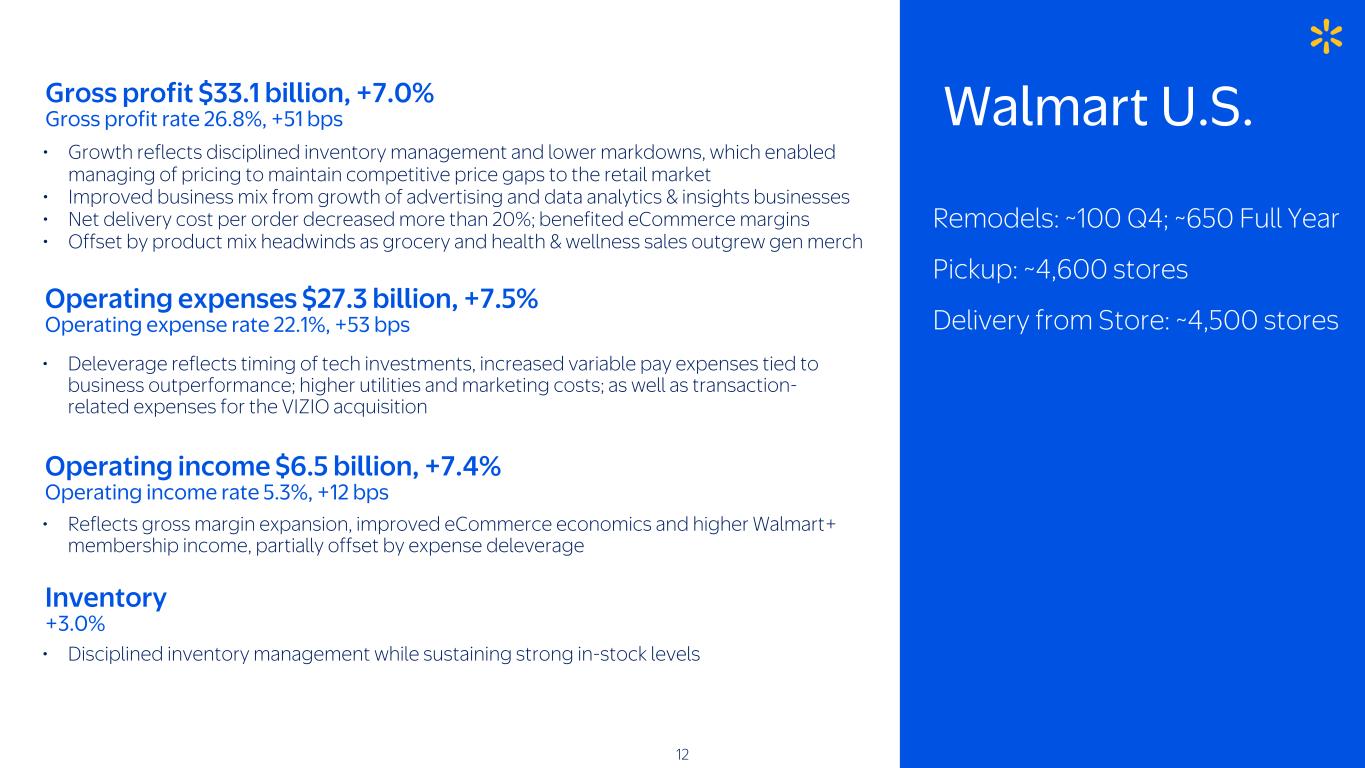
Remodels: ~100 Q4; ~650 Full Year Pickup: ~4,600 stores Delivery from Store: ~4,500 stores • Growth reflects disciplined inventory management and lower markdowns, which enabled managing of pricing to maintain competitive price gaps to the retail market • Improved business mix from growth of advertising and data analytics & insights businesses • Net delivery cost per order decreased more than 20%; benefited eCommerce margins • Offset by product mix headwinds as grocery and health & wellness sales outgrew gen merch Gross profit $33.1 billion, +7.0% Gross profit rate 26.8%, +51 bps • Deleverage reflects timing of tech investments, increased variable pay expenses tied to business outperformance; higher utilities and marketing costs; as well as transaction- related expenses for the VIZIO acquisition Operating expenses $27.3 billion, +7.5% Operating expense rate 22.1%, +53 bps • Reflects gross margin expansion, improved eCommerce economics and higher Walmart+ membership income, partially offset by expense deleverage Operating income $6.5 billion, +7.4% Operating income rate 5.3%, +12 bps • Disciplined inventory management while sustaining strong in-stock levels Inventory +3.0% Walmart U.S. 12
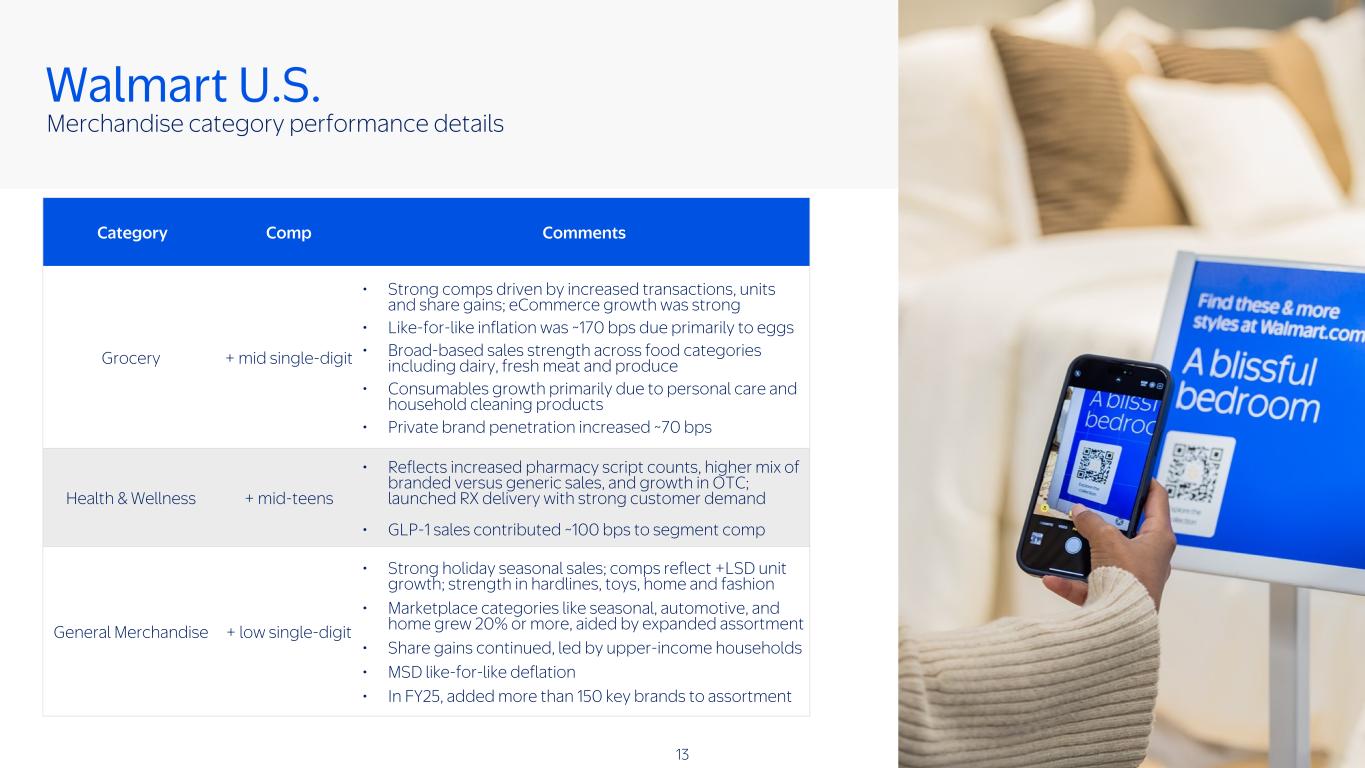
Merchandise category performance details Walmart U.S. Category Comp Comments Grocery + mid single-digit • Strong comps driven by increased transactions, units and share gains; eCommerce growth was strong • Like-for-like inflation was ~170 bps due primarily to eggs • Broad-based sales strength across food categories including dairy, fresh meat and produce • Consumables growth primarily due to personal care and household cleaning products • Private brand penetration increased ~70 bps Health & Wellness + mid-teens • Reflects increased pharmacy script counts, higher mix of branded versus generic sales, and growth in OTC; launched RX delivery with strong customer demand • GLP-1 sales contributed ~100 bps to segment comp General Merchandise + low single-digit • Strong holiday seasonal sales; comps reflect +LSD unit growth; strength in hardlines, toys, home and fashion • Marketplace categories like seasonal, automotive, and home grew 20% or more, aided by expanded assortment • Share gains continued, led by upper-income households • MSD like-for-like deflation • In FY25, added more than 150 key brands to assortment 13
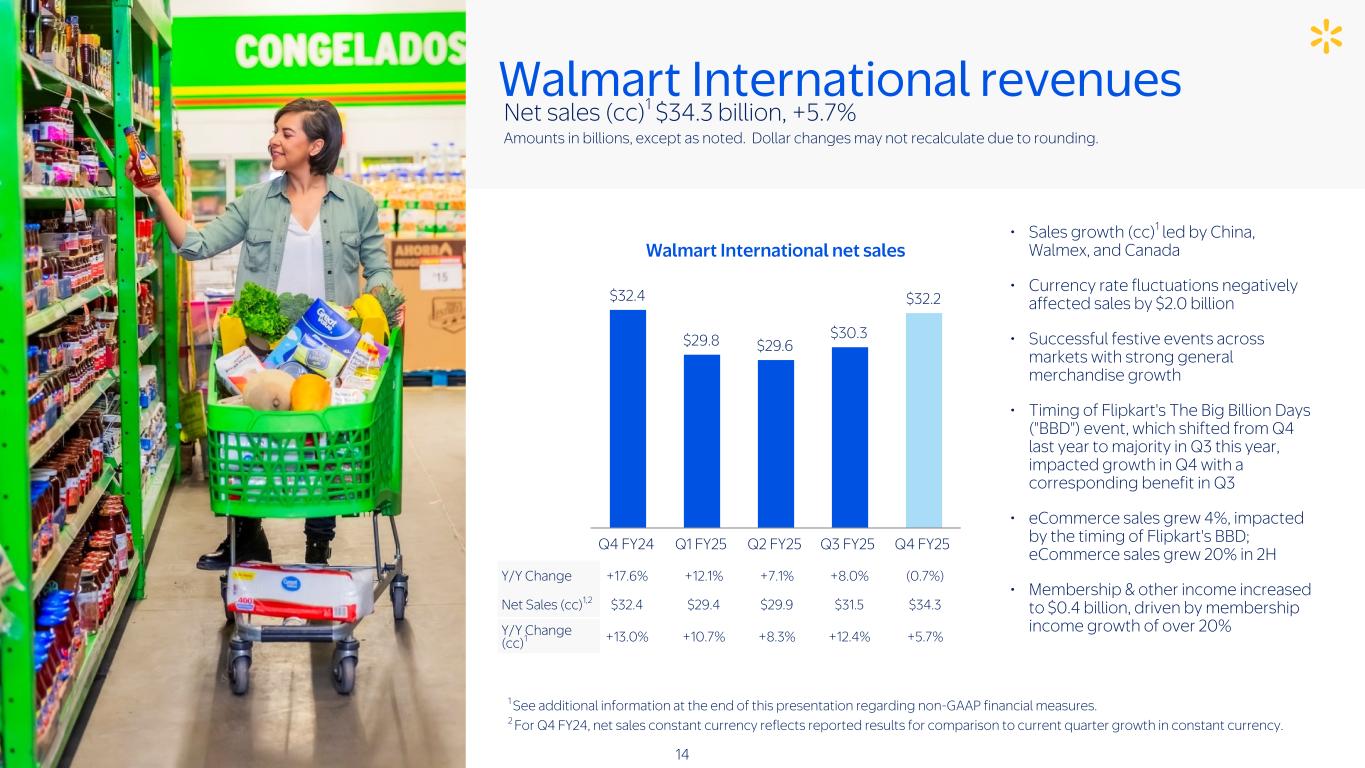
Net sales (cc)1 $34.3 billion, +5.7% Amounts in billions, except as noted. Dollar changes may not recalculate due to rounding. • Sales growth (cc)1 led by China, Walmex, and Canada • Currency rate fluctuations negatively affected sales by $2.0 billion • Successful festive events across markets with strong general merchandise growth • Timing of Flipkart's The Big Billion Days ("BBD") event, which shifted from Q4 last year to majority in Q3 this year, impacted growth in Q4 with a corresponding benefit in Q3 • eCommerce sales grew 4%, impacted by the timing of Flipkart's BBD; eCommerce sales grew 20% in 2H • Membership & other income increased to $0.4 billion, driven by membership income growth of over 20% Y/Y Change +17.6% +12.1% +7.1% +8.0% (0.7%) Net Sales (cc)1,2 $32.4 $29.4 $29.9 $31.5 $34.3 Y/Y Change (cc)1 +13.0% +10.7% +8.3% +12.4% +5.7% Walmart International revenues $32.4 $29.8 $29.6 $30.3 $32.2 Q4 FY24 Q1 FY25 Q2 FY25 Q3 FY25 Q4 FY25 1 See additional information at the end of this presentation regarding non-GAAP financial measures. 2 For Q4 FY24, net sales constant currency reflects reported results for comparison to current quarter growth in constant currency. 14 Walmart International net sales
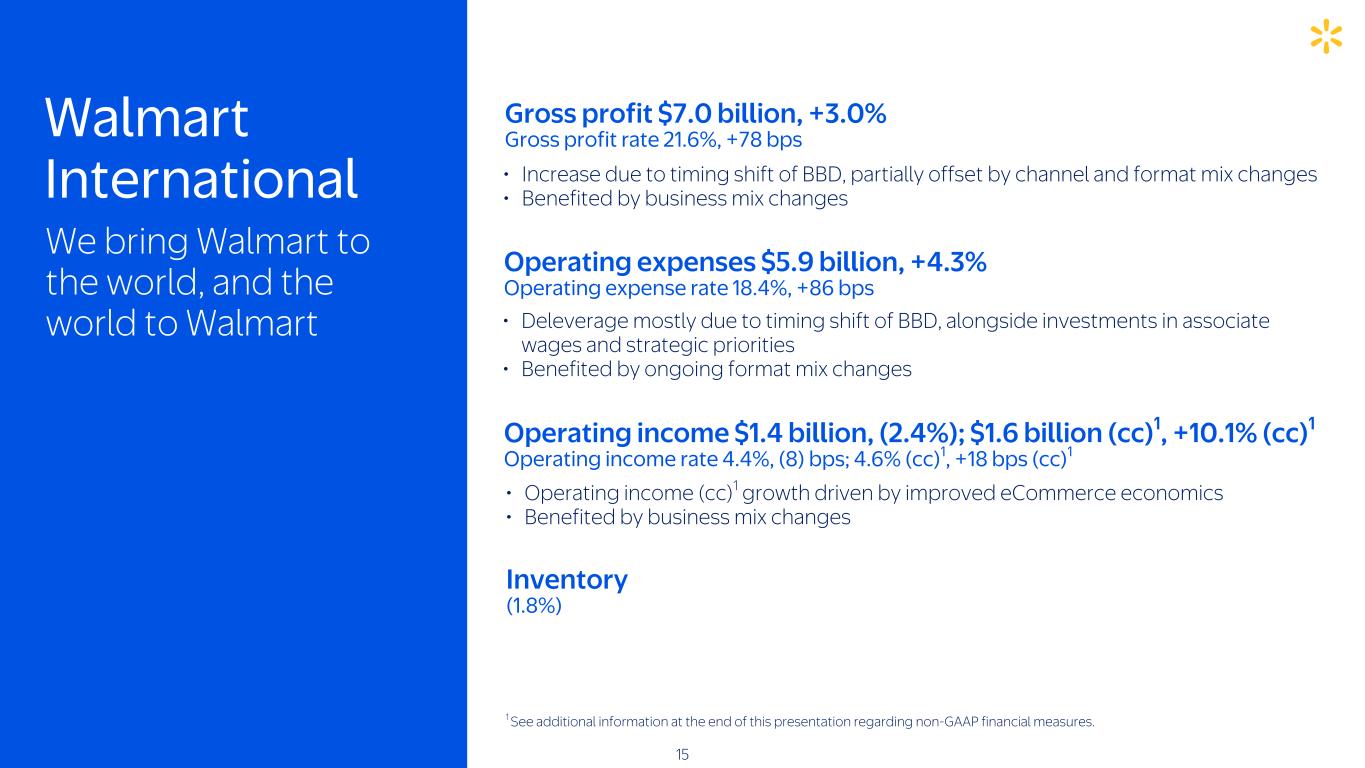
• Increase due to timing shift of BBD, partially offset by channel and format mix changes • Benefited by business mix changes 1 See additional information at the end of this presentation regarding non-GAAP financial measures. Gross profit $7.0 billion, +3.0% Gross profit rate 21.6%, +78 bps • Deleverage mostly due to timing shift of BBD, alongside investments in associate wages and strategic priorities • Benefited by ongoing format mix changes Operating expenses $5.9 billion, +4.3% Operating expense rate 18.4%, +86 bps • Operating income (cc)1 growth driven by improved eCommerce economics • Benefited by business mix changes Operating income $1.4 billion, (2.4%); $1.6 billion (cc)1, +10.1% (cc)1 Operating income rate 4.4%, (8) bps; 4.6% (cc)1, +18 bps (cc)1 Inventory (1.8%) Walmart International 15 We bring Walmart to the world, and the world to Walmart
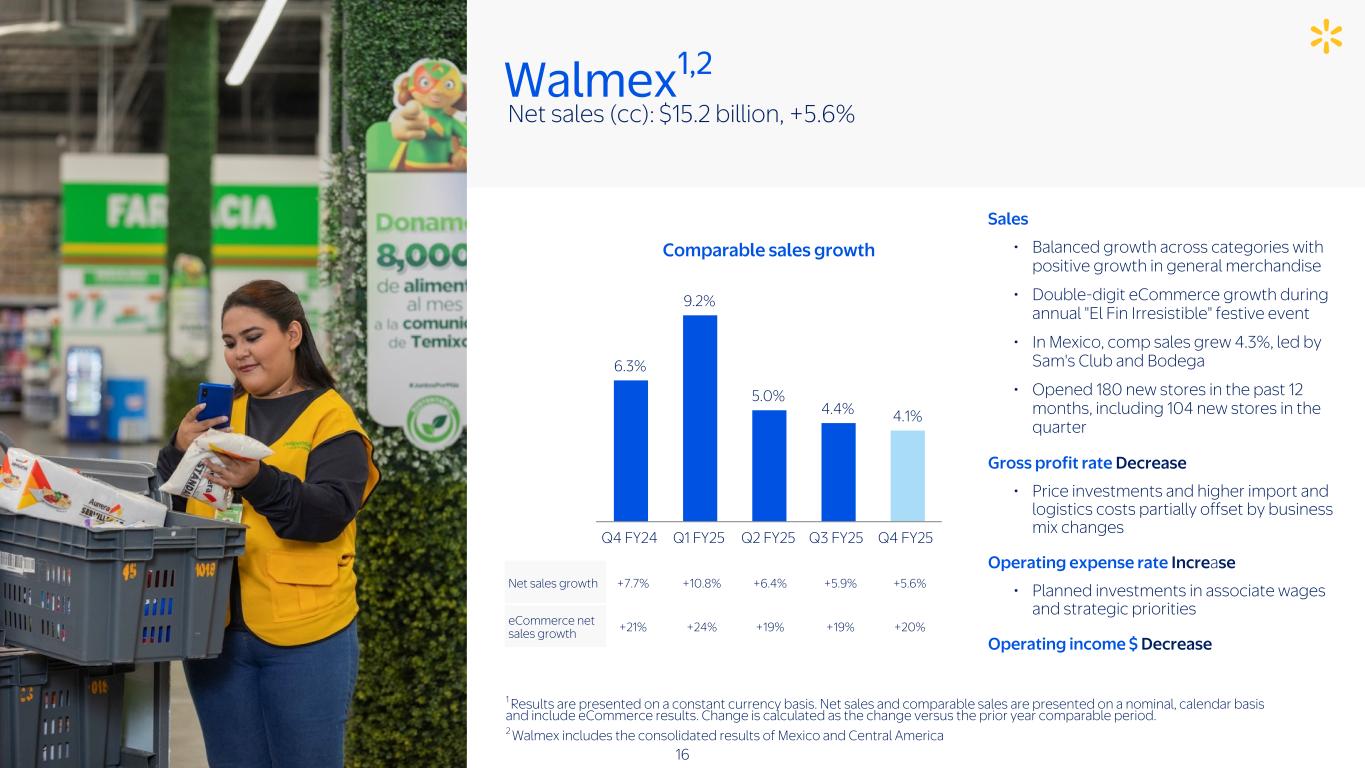
Sales • Balanced growth across categories with positive growth in general merchandise • Double-digit eCommerce growth during annual "El Fin Irresistible" festive event • In Mexico, comp sales grew 4.3%, led by Sam's Club and Bodega • Opened 180 new stores in the past 12 months, including 104 new stores in the quarter Gross profit rate Decrease • Price investments and higher import and logistics costs partially offset by business mix changes Operating expense rate Increase • Planned investments in associate wages and strategic priorities Operating income $ Decrease Net sales growth +7.7% +10.8% +6.4% +5.9% +5.6% eCommerce net sales growth +21% +24% +19% +19% +20% 1 Results are presented on a constant currency basis. Net sales and comparable sales are presented on a nominal, calendar basis and include eCommerce results. Change is calculated as the change versus the prior year comparable period. 2 Walmex includes the consolidated results of Mexico and Central America Walmex1,2 Net sales (cc): $15.2 billion, +5.6% 6.3% 9.2% 5.0% 4.4% 4.1% Q4 FY24 Q1 FY25 Q2 FY25 Q3 FY25 Q4 FY25 16 Comparable sales growth
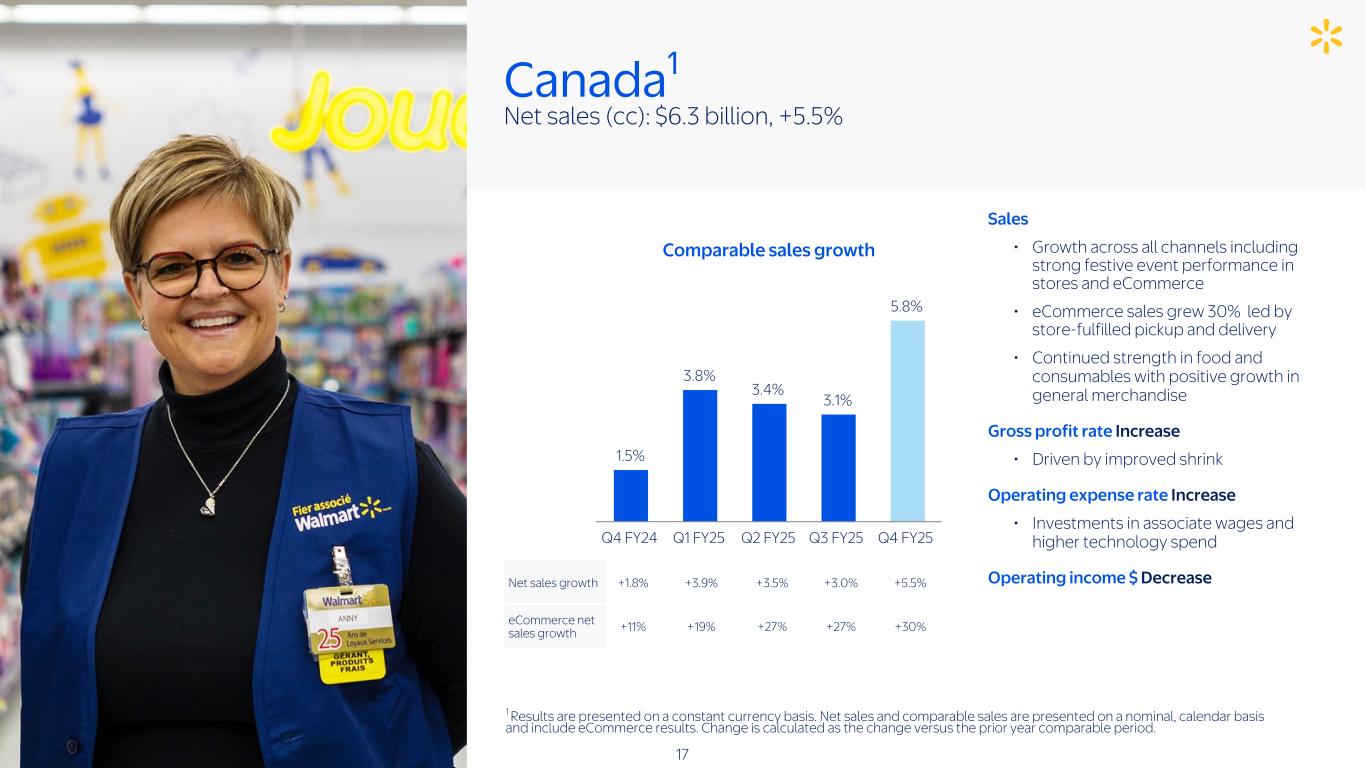
Net sales growth +1.8% +3.9% +3.5% +3.0% +5.5% eCommerce net sales growth +11% +19% +27% +27% +30% 1 Results are presented on a constant currency basis. Net sales and comparable sales are presented on a nominal, calendar basis and include eCommerce results. Change is calculated as the change versus the prior year comparable period. Canada1 Net sales (cc): $6.3 billion, +5.5% 1.5% 3.8% 3.4% 3.1% 5.8% Q4 FY24 Q1 FY25 Q2 FY25 Q3 FY25 Q4 FY25 Sales • Growth across all channels including strong festive event performance in stores and eCommerce • eCommerce sales grew 30% led by store-fulfilled pickup and delivery • Continued strength in food and consumables with positive growth in general merchandise Gross profit rate Increase • Driven by improved shrink Operating expense rate Increase • Investments in associate wages and higher technology spend Operating income $ Decrease 17 Comparable sales growth

Net sales growth +11.3% +16.2% +17.7% +17.0% +27.7% eCommerce net sales growth +11% +23% +23% +25% +34% 1 Results are presented on a constant currency basis. Net sales and comparable sales are presented on a nominal, calendar basis and include eCommerce results. Change is calculated as the change versus the prior year comparable period. China1 Net sales (cc): $5.1 billion, +27.7% 6.6% 12.5% 13.8% 15.0% 23.1% Q4 FY24 Q1 FY25 Q2 FY25 Q3 FY25 Q4 FY25 Sales • Continued strength in Sam’s Club and eCommerce, with eCommerce sales growth of 34% • Opened 6 new clubs in the past 12 months, including 4 new clubs in the quarter • Growth positively affected by earlier Lunar New Year shopping season Gross profit rate Increase • Primarily due to merchandise mix changes, partially offset by ongoing format mix changes Operating expense rate Decrease • Driven by strong sales growth, format mix changes, and operational efficiencies Operating income $ Increase 18 Comparable sales growth
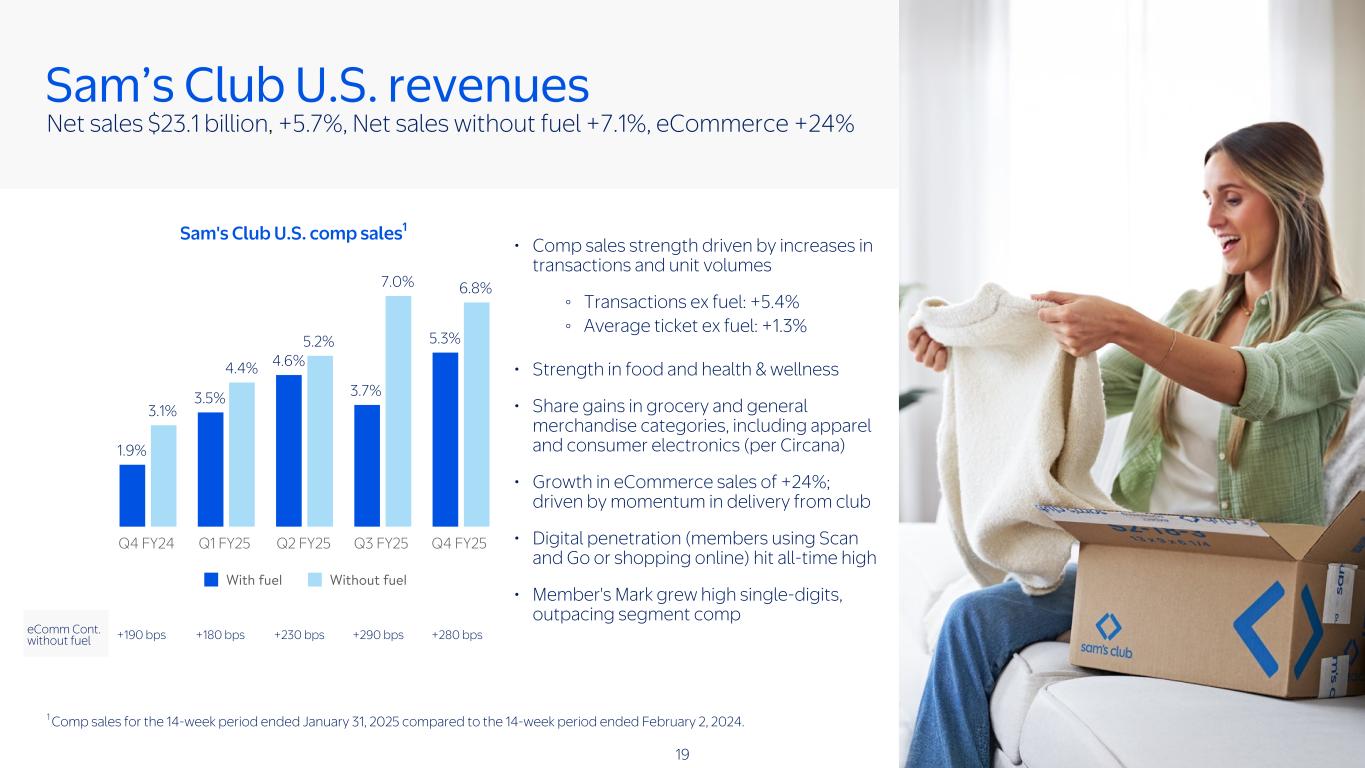
Net sales $23.1 billion, +5.7%, Net sales without fuel +7.1%, eCommerce +24% • Comp sales strength driven by increases in transactions and unit volumes ◦ Transactions ex fuel: +5.4% ◦ Average ticket ex fuel: +1.3% • Strength in food and health & wellness • Share gains in grocery and general merchandise categories, including apparel and consumer electronics (per Circana) • Growth in eCommerce sales of +24%; driven by momentum in delivery from club • Digital penetration (members using Scan and Go or shopping online) hit all-time high • Member's Mark grew high single-digits, outpacing segment comp eComm Cont. without fuel +190 bps +180 bps +230 bps +290 bps +280 bps 1 Comp sales for the 14-week period ended January 31, 2025 compared to the 14-week period ended February 2, 2024. Sam’s Club U.S. revenues 1.9% 3.5% 4.6% 3.7% 5.3% 3.1% 4.4% 5.2% 7.0% 6.8% With fuel Without fuel Q4 FY24 Q1 FY25 Q2 FY25 Q3 FY25 Q4 FY25 19 Sam's Club U.S. comp sales1
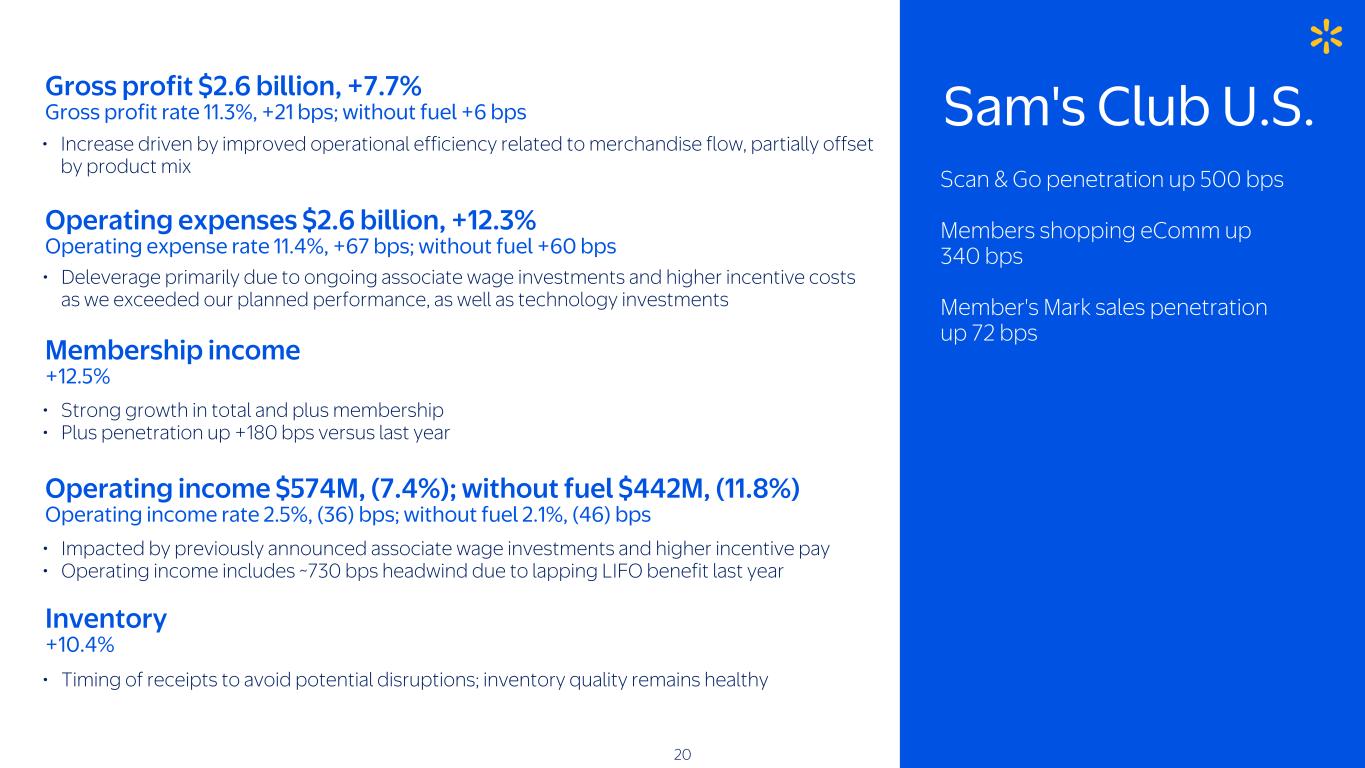
• Increase driven by improved operational efficiency related to merchandise flow, partially offset by product mix • Deleverage primarily due to ongoing associate wage investments and higher incentive costs as we exceeded our planned performance, as well as technology investments Operating expenses $2.6 billion, +12.3% Operating expense rate 11.4%, +67 bps; without fuel +60 bps Gross profit $2.6 billion, +7.7% Gross profit rate 11.3%, +21 bps; without fuel +6 bps • Strong growth in total and plus membership • Plus penetration up +180 bps versus last year Membership income +12.5% Operating income $574M, (7.4%); without fuel $442M, (11.8%) Operating income rate 2.5%, (36) bps; without fuel 2.1%, (46) bps • Impacted by previously announced associate wage investments and higher incentive pay • Operating income includes ~730 bps headwind due to lapping LIFO benefit last year 20 Inventory +10.4% • Timing of receipts to avoid potential disruptions; inventory quality remains healthy Scan & Go penetration up 500 bps Members shopping eComm up 340 bps Member's Mark sales penetration up 72 bps Sam's Club U.S.
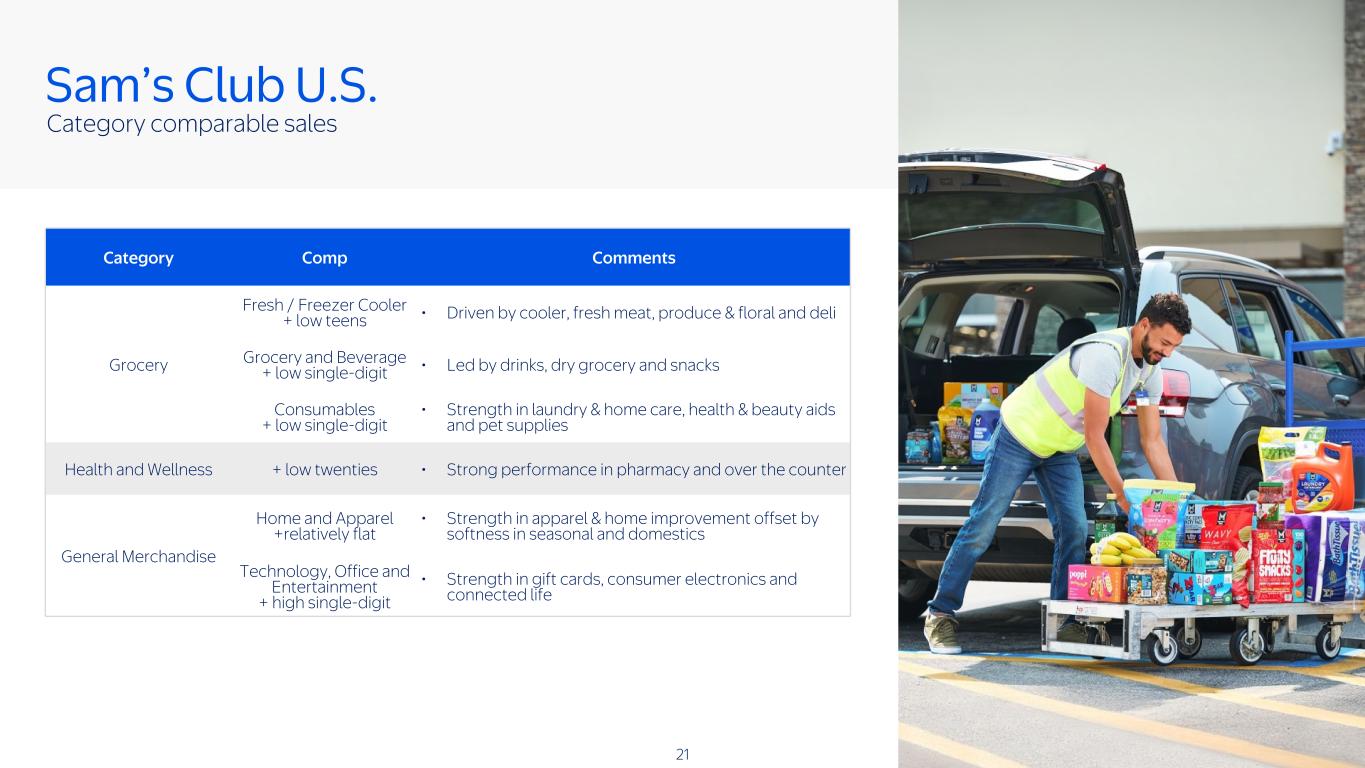
Category comparable sales Sam’s Club U.S. Category Comp Comments Grocery Fresh / Freezer Cooler + low teens • Driven by cooler, fresh meat, produce & floral and deli Grocery and Beverage + low single-digit • Led by drinks, dry grocery and snacks Consumables + low single-digit • Strength in laundry & home care, health & beauty aids and pet supplies Health and Wellness + low twenties • Strong performance in pharmacy and over the counter General Merchandise Home and Apparel +relatively flat • Strength in apparel & home improvement offset by softness in seasonal and domestics Technology, Office and Entertainment + high single-digit • Strength in gift cards, consumer electronics and connected life 21
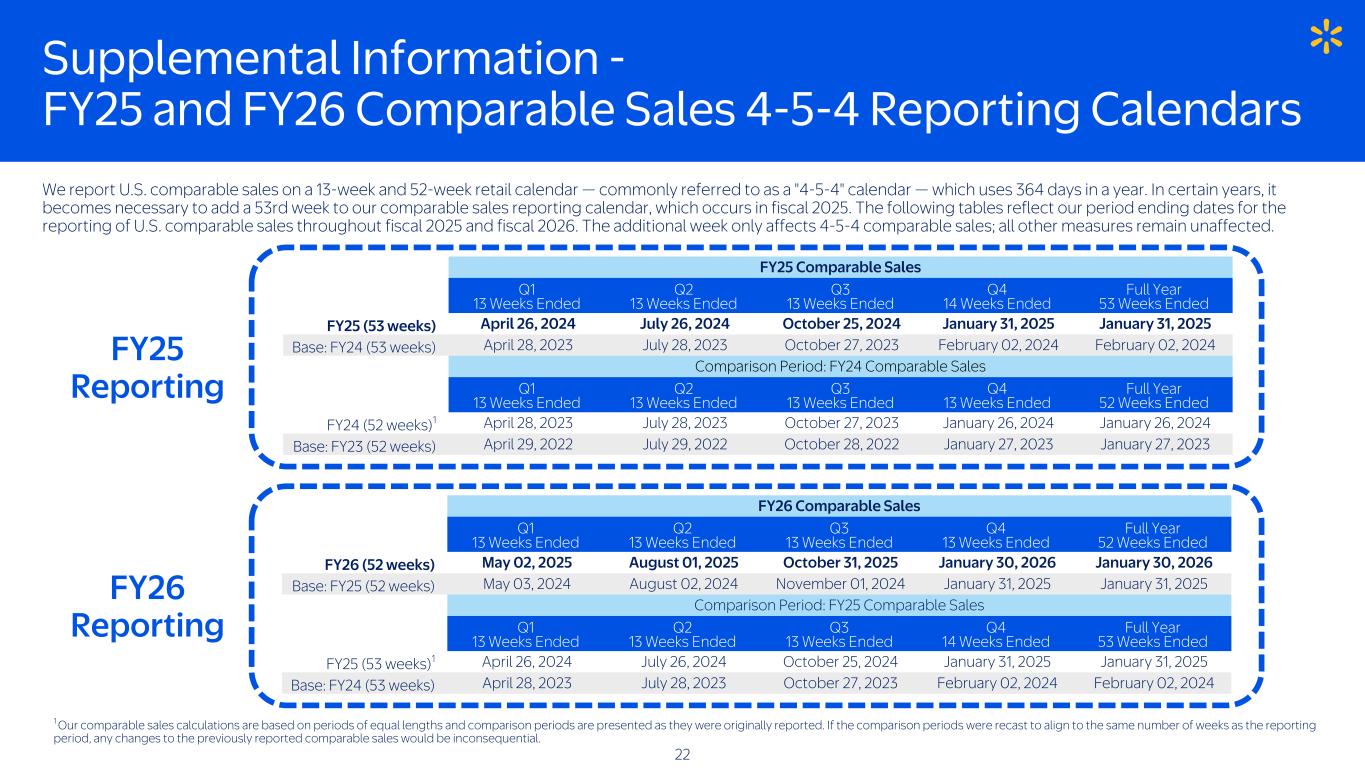
Supplemental Information - FY25 and FY26 Comparable Sales 4-5-4 Reporting Calendars We report U.S. comparable sales on a 13-week and 52-week retail calendar — commonly referred to as a "4-5-4" calendar — which uses 364 days in a year. In certain years, it becomes necessary to add a 53rd week to our comparable sales reporting calendar, which occurs in fiscal 2025. The following tables reflect our period ending dates for the reporting of U.S. comparable sales throughout fiscal 2025 and fiscal 2026. The additional week only affects 4-5-4 comparable sales; all other measures remain unaffected. FY25 Comparable Sales Q1 13 Weeks Ended Q2 13 Weeks Ended Q3 13 Weeks Ended Q4 14 Weeks Ended Full Year 53 Weeks Ended FY25 (53 weeks) April 26, 2024 July 26, 2024 October 25, 2024 January 31, 2025 January 31, 2025 Base: FY24 (53 weeks) April 28, 2023 July 28, 2023 October 27, 2023 February 02, 2024 February 02, 2024 Comparison Period: FY24 Comparable Sales Q1 13 Weeks Ended Q2 13 Weeks Ended Q3 13 Weeks Ended Q4 13 Weeks Ended Full Year 52 Weeks Ended FY24 (52 weeks)1 April 28, 2023 July 28, 2023 October 27, 2023 January 26, 2024 January 26, 2024 Base: FY23 (52 weeks) April 29, 2022 July 29, 2022 October 28, 2022 January 27, 2023 January 27, 2023 FY25 Reporting FY26 Comparable Sales Q1 13 Weeks Ended Q2 13 Weeks Ended Q3 13 Weeks Ended Q4 13 Weeks Ended Full Year 52 Weeks Ended FY26 (52 weeks) May 02, 2025 August 01, 2025 October 31, 2025 January 30, 2026 January 30, 2026 Base: FY25 (52 weeks) May 03, 2024 August 02, 2024 November 01, 2024 January 31, 2025 January 31, 2025 Comparison Period: FY25 Comparable Sales Q1 13 Weeks Ended Q2 13 Weeks Ended Q3 13 Weeks Ended Q4 14 Weeks Ended Full Year 53 Weeks Ended FY25 (53 weeks)1 April 26, 2024 July 26, 2024 October 25, 2024 January 31, 2025 January 31, 2025 Base: FY24 (53 weeks) April 28, 2023 July 28, 2023 October 27, 2023 February 02, 2024 February 02, 2024 FY26 Reporting 1 Our comparable sales calculations are based on periods of equal lengths and comparison periods are presented as they were originally reported. If the comparison periods were recast to align to the same number of weeks as the reporting period, any changes to the previously reported comparable sales would be inconsequential. 22
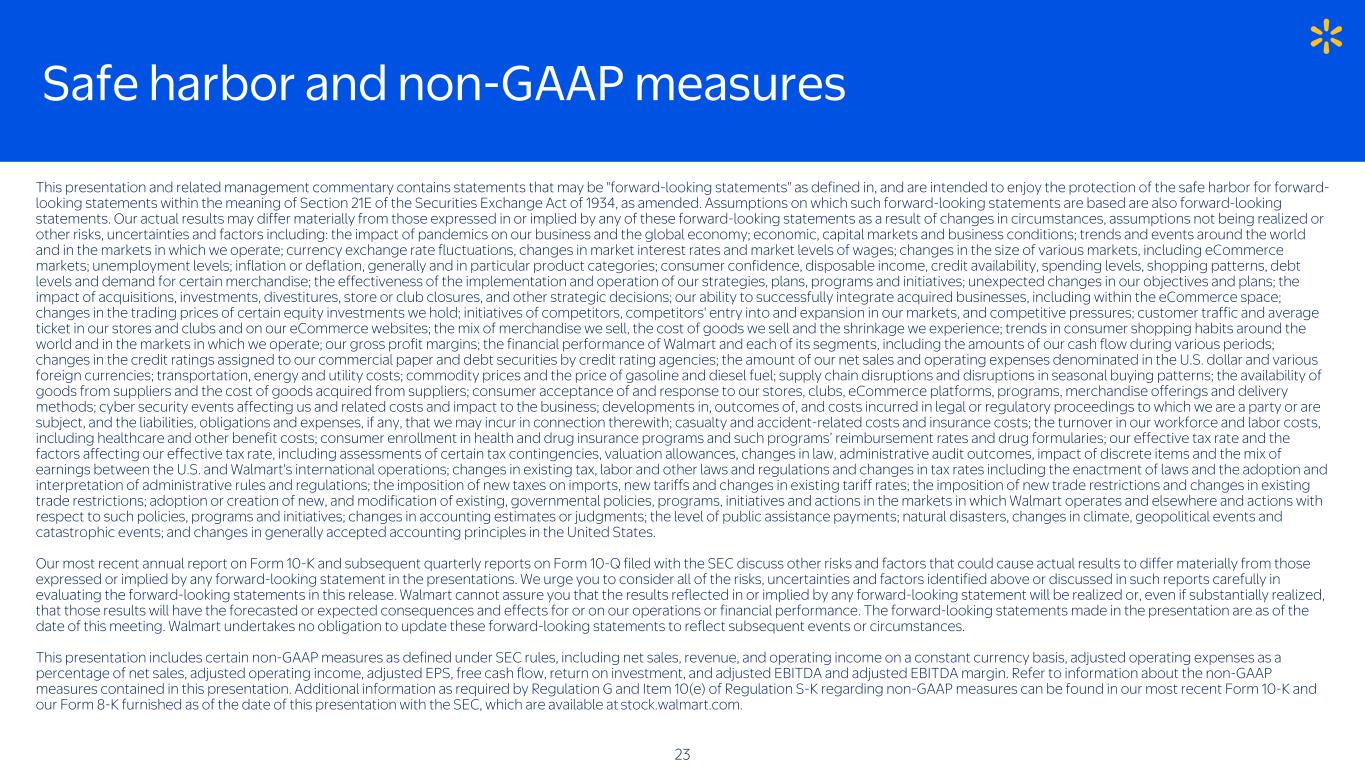
Safe harbor and non-GAAP measures This presentation and related management commentary contains statements that may be "forward-looking statements" as defined in, and are intended to enjoy the protection of the safe harbor for forward- looking statements within the meaning of Section 21E of the Securities Exchange Act of 1934, as amended. Assumptions on which such forward-looking statements are based are also forward-looking statements. Our actual results may differ materially from those expressed in or implied by any of these forward-looking statements as a result of changes in circumstances, assumptions not being realized or other risks, uncertainties and factors including: the impact of pandemics on our business and the global economy; economic, capital markets and business conditions; trends and events around the world and in the markets in which we operate; currency exchange rate fluctuations, changes in market interest rates and market levels of wages; changes in the size of various markets, including eCommerce markets; unemployment levels; inflation or deflation, generally and in particular product categories; consumer confidence, disposable income, credit availability, spending levels, shopping patterns, debt levels and demand for certain merchandise; the effectiveness of the implementation and operation of our strategies, plans, programs and initiatives; unexpected changes in our objectives and plans; the impact of acquisitions, investments, divestitures, store or club closures, and other strategic decisions; our ability to successfully integrate acquired businesses, including within the eCommerce space; changes in the trading prices of certain equity investments we hold; initiatives of competitors, competitors' entry into and expansion in our markets, and competitive pressures; customer traffic and average ticket in our stores and clubs and on our eCommerce websites; the mix of merchandise we sell, the cost of goods we sell and the shrinkage we experience; trends in consumer shopping habits around the world and in the markets in which we operate; our gross profit margins; the financial performance of Walmart and each of its segments, including the amounts of our cash flow during various periods; changes in the credit ratings assigned to our commercial paper and debt securities by credit rating agencies; the amount of our net sales and operating expenses denominated in the U.S. dollar and various foreign currencies; transportation, energy and utility costs; commodity prices and the price of gasoline and diesel fuel; supply chain disruptions and disruptions in seasonal buying patterns; the availability of goods from suppliers and the cost of goods acquired from suppliers; consumer acceptance of and response to our stores, clubs, eCommerce platforms, programs, merchandise offerings and delivery methods; cyber security events affecting us and related costs and impact to the business; developments in, outcomes of, and costs incurred in legal or regulatory proceedings to which we are a party or are subject, and the liabilities, obligations and expenses, if any, that we may incur in connection therewith; casualty and accident-related costs and insurance costs; the turnover in our workforce and labor costs, including healthcare and other benefit costs; consumer enrollment in health and drug insurance programs and such programs’ reimbursement rates and drug formularies; our effective tax rate and the factors affecting our effective tax rate, including assessments of certain tax contingencies, valuation allowances, changes in law, administrative audit outcomes, impact of discrete items and the mix of earnings between the U.S. and Walmart's international operations; changes in existing tax, labor and other laws and regulations and changes in tax rates including the enactment of laws and the adoption and interpretation of administrative rules and regulations; the imposition of new taxes on imports, new tariffs and changes in existing tariff rates; the imposition of new trade restrictions and changes in existing trade restrictions; adoption or creation of new, and modification of existing, governmental policies, programs, initiatives and actions in the markets in which Walmart operates and elsewhere and actions with respect to such policies, programs and initiatives; changes in accounting estimates or judgments; the level of public assistance payments; natural disasters, changes in climate, geopolitical events and catastrophic events; and changes in generally accepted accounting principles in the United States. Our most recent annual report on Form 10-K and subsequent quarterly reports on Form 10-Q filed with the SEC discuss other risks and factors that could cause actual results to differ materially from those expressed or implied by any forward-looking statement in the presentations. We urge you to consider all of the risks, uncertainties and factors identified above or discussed in such reports carefully in evaluating the forward-looking statements in this release. Walmart cannot assure you that the results reflected in or implied by any forward-looking statement will be realized or, even if substantially realized, that those results will have the forecasted or expected consequences and effects for or on our operations or financial performance. The forward-looking statements made in the presentation are as of the date of this meeting. Walmart undertakes no obligation to update these forward-looking statements to reflect subsequent events or circumstances. This presentation includes certain non-GAAP measures as defined under SEC rules, including net sales, revenue, and operating income on a constant currency basis, adjusted operating expenses as a percentage of net sales, adjusted operating income, adjusted EPS, free cash flow, return on investment, and adjusted EBITDA and adjusted EBITDA margin. Refer to information about the non-GAAP measures contained in this presentation. Additional information as required by Regulation G and Item 10(e) of Regulation S-K regarding non-GAAP measures can be found in our most recent Form 10-K and our Form 8-K furnished as of the date of this presentation with the SEC, which are available at stock.walmart.com. 23
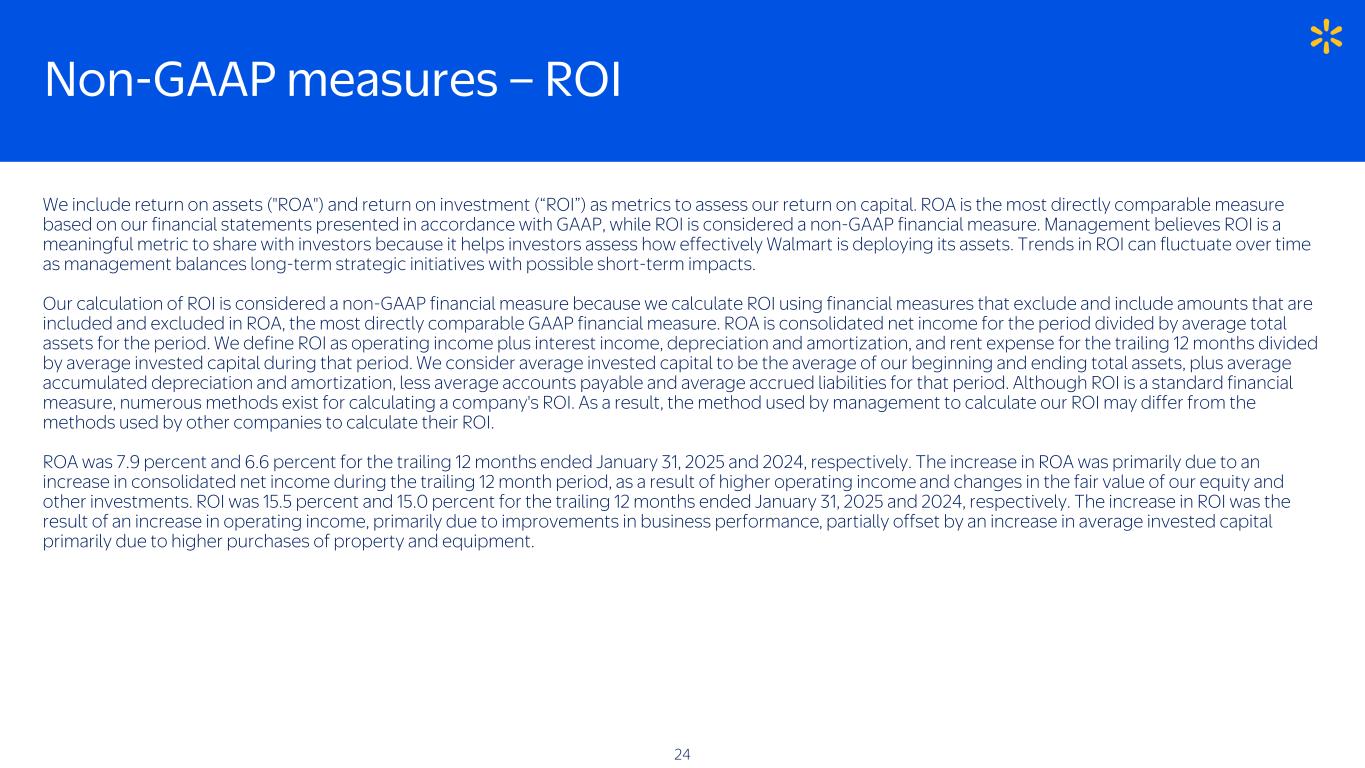
Non-GAAP measures – ROI We include return on assets ("ROA") and return on investment (“ROI”) as metrics to assess our return on capital. ROA is the most directly comparable measure based on our financial statements presented in accordance with GAAP, while ROI is considered a non-GAAP financial measure. Management believes ROI is a meaningful metric to share with investors because it helps investors assess how effectively Walmart is deploying its assets. Trends in ROI can fluctuate over time as management balances long-term strategic initiatives with possible short-term impacts. Our calculation of ROI is considered a non-GAAP financial measure because we calculate ROI using financial measures that exclude and include amounts that are included and excluded in ROA, the most directly comparable GAAP financial measure. ROA is consolidated net income for the period divided by average total assets for the period. We define ROI as operating income plus interest income, depreciation and amortization, and rent expense for the trailing 12 months divided by average invested capital during that period. We consider average invested capital to be the average of our beginning and ending total assets, plus average accumulated depreciation and amortization, less average accounts payable and average accrued liabilities for that period. Although ROI is a standard financial measure, numerous methods exist for calculating a company's ROI. As a result, the method used by management to calculate our ROI may differ from the methods used by other companies to calculate their ROI. ROA was 7.9 percent and 6.6 percent for the trailing 12 months ended January 31, 2025 and 2024, respectively. The increase in ROA was primarily due to an increase in consolidated net income during the trailing 12 month period, as a result of higher operating income and changes in the fair value of our equity and other investments. ROI was 15.5 percent and 15.0 percent for the trailing 12 months ended January 31, 2025 and 2024, respectively. The increase in ROI was the result of an increase in operating income, primarily due to improvements in business performance, partially offset by an increase in average invested capital primarily due to higher purchases of property and equipment. 24
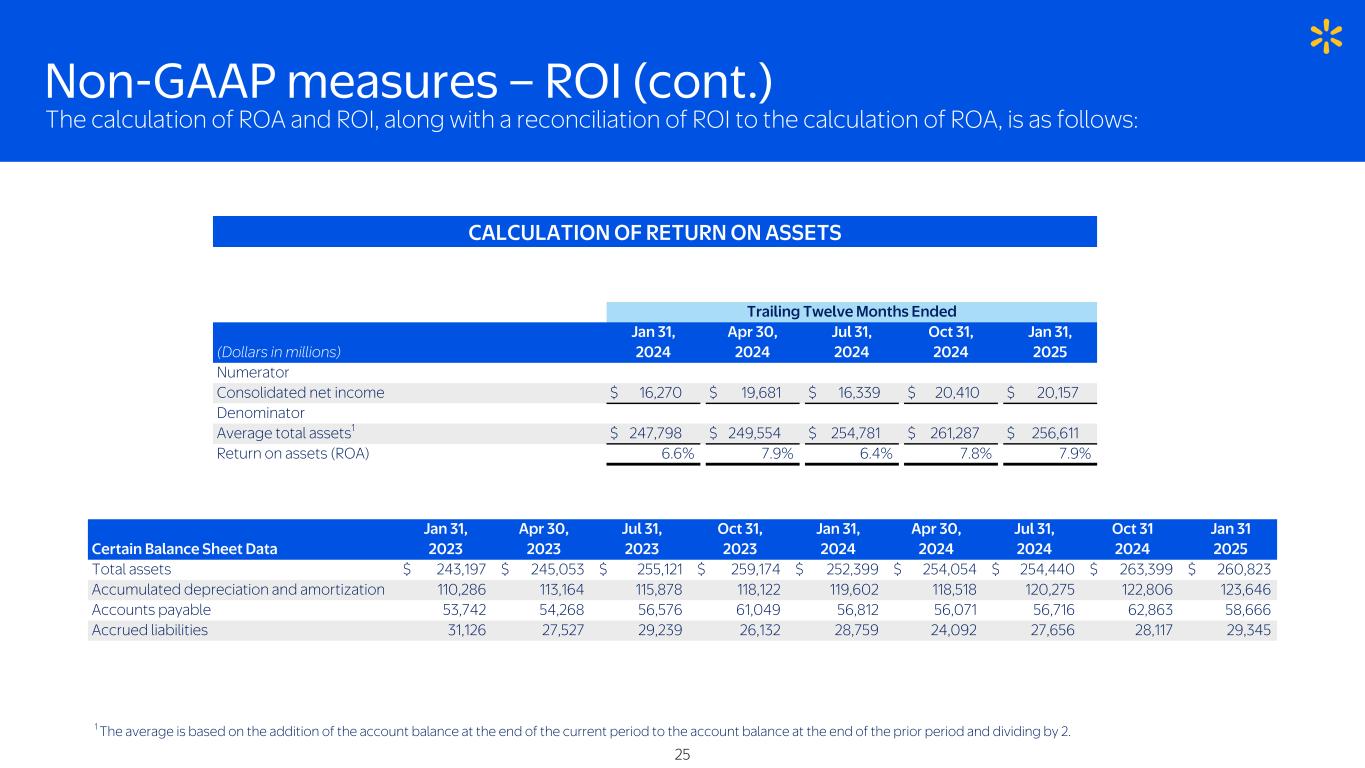
The calculation of ROA and ROI, along with a reconciliation of ROI to the calculation of ROA, is as follows: Non-GAAP measures – ROI (cont.) Trailing Twelve Months Ended Jan 31, Apr 30, Jul 31, Oct 31, Jan 31, (Dollars in millions) 2024 2024 2024 2024 2025 Numerator Consolidated net income $ 16,270 $ 19,681 $ 16,339 $ 20,410 $ 20,157 Denominator Average total assets1 $ 247,798 $ 249,554 $ 254,781 $ 261,287 $ 256,611 Return on assets (ROA) 6.6% 7.9% 6.4% 7.8% 7.9% 1 The average is based on the addition of the account balance at the end of the current period to the account balance at the end of the prior period and dividing by 2. 25 Jan 31, Apr 30, Jul 31, Oct 31, Jan 31, Apr 30, Jul 31, Oct 31 Jan 31 Certain Balance Sheet Data 2023 2023 2023 2023 2024 2024 2024 2024 2025 Total assets $ 243,197 $ 245,053 $ 255,121 $ 259,174 $ 252,399 $ 254,054 $ 254,440 $ 263,399 $ 260,823 Accumulated depreciation and amortization 110,286 113,164 115,878 118,122 119,602 118,518 120,275 122,806 123,646 Accounts payable 53,742 54,268 56,576 61,049 56,812 56,071 56,716 62,863 58,666 Accrued liabilities 31,126 27,527 29,239 26,132 28,759 24,092 27,656 28,117 29,345 CALCULATION OF RETURN ON ASSETS
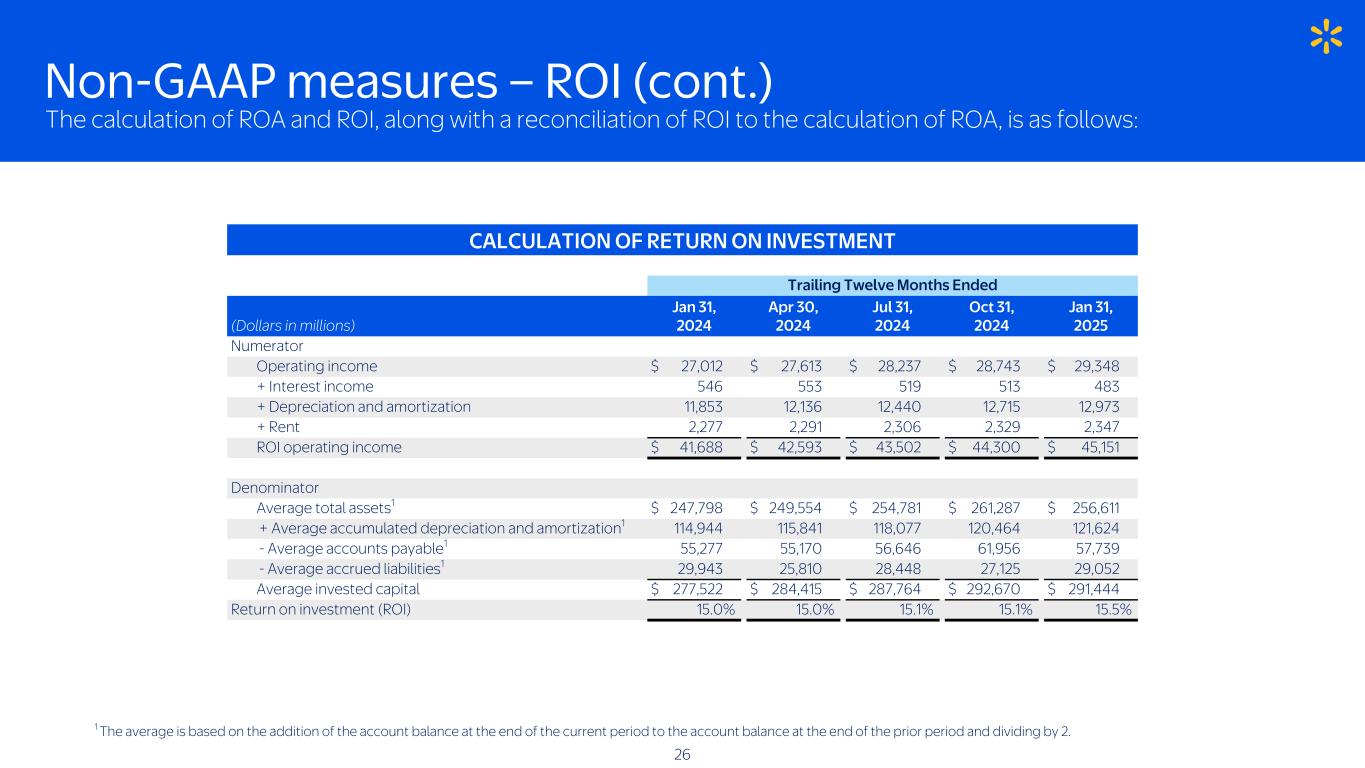
The calculation of ROA and ROI, along with a reconciliation of ROI to the calculation of ROA, is as follows: Non-GAAP measures – ROI (cont.) CALCULATION OF RETURN ON INVESTMENT Trailing Twelve Months Ended Jan 31, Apr 30, Jul 31, Oct 31, Jan 31, (Dollars in millions) 2024 2024 2024 2024 2025 Numerator Operating income $ 27,012 $ 27,613 $ 28,237 $ 28,743 $ 29,348 + Interest income 546 553 519 513 483 + Depreciation and amortization 11,853 12,136 12,440 12,715 12,973 + Rent 2,277 2,291 2,306 2,329 2,347 ROI operating income $ 41,688 $ 42,593 $ 43,502 $ 44,300 $ 45,151 Denominator Average total assets1 $ 247,798 $ 249,554 $ 254,781 $ 261,287 $ 256,611 '+ Average accumulated depreciation and amortization1 114,944 115,841 118,077 120,464 121,624 '- Average accounts payable1 55,277 55,170 56,646 61,956 57,739 '- Average accrued liabilities1 29,943 25,810 28,448 27,125 29,052 Average invested capital $ 277,522 $ 284,415 $ 287,764 $ 292,670 $ 291,444 Return on investment (ROI) 15.0% 15.0% 15.1% 15.1% 15.5% 1 The average is based on the addition of the account balance at the end of the current period to the account balance at the end of the prior period and dividing by 2. 26
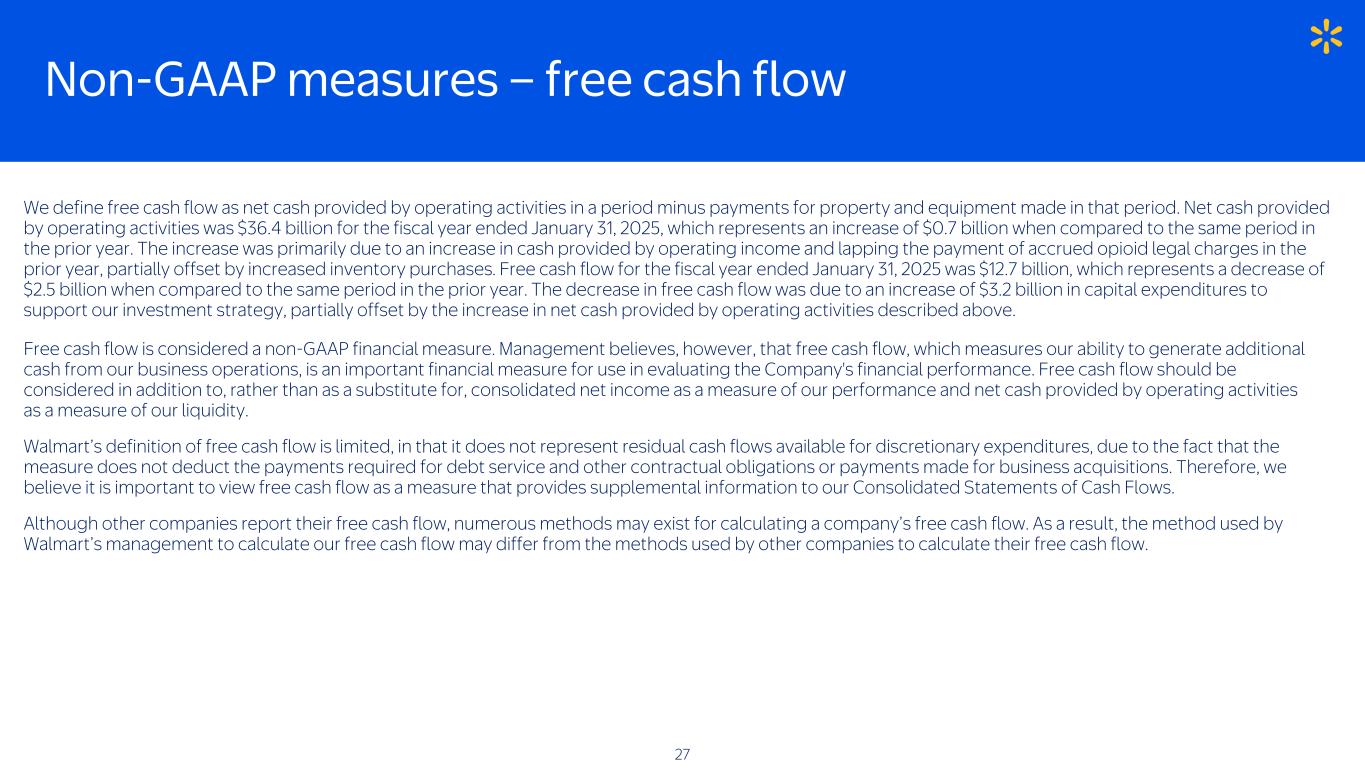
Non-GAAP measures – free cash flow We define free cash flow as net cash provided by operating activities in a period minus payments for property and equipment made in that period. Net cash provided by operating activities was $36.4 billion for the fiscal year ended January 31, 2025, which represents an increase of $0.7 billion when compared to the same period in the prior year. The increase was primarily due to an increase in cash provided by operating income and lapping the payment of accrued opioid legal charges in the prior year, partially offset by increased inventory purchases. Free cash flow for the fiscal year ended January 31, 2025 was $12.7 billion, which represents a decrease of $2.5 billion when compared to the same period in the prior year. The decrease in free cash flow was due to an increase of $3.2 billion in capital expenditures to support our investment strategy, partially offset by the increase in net cash provided by operating activities described above. Free cash flow is considered a non-GAAP financial measure. Management believes, however, that free cash flow, which measures our ability to generate additional cash from our business operations, is an important financial measure for use in evaluating the Company's financial performance. Free cash flow should be considered in addition to, rather than as a substitute for, consolidated net income as a measure of our performance and net cash provided by operating activities as a measure of our liquidity. Walmart’s definition of free cash flow is limited, in that it does not represent residual cash flows available for discretionary expenditures, due to the fact that the measure does not deduct the payments required for debt service and other contractual obligations or payments made for business acquisitions. Therefore, we believe it is important to view free cash flow as a measure that provides supplemental information to our Consolidated Statements of Cash Flows. Although other companies report their free cash flow, numerous methods may exist for calculating a company’s free cash flow. As a result, the method used by Walmart’s management to calculate our free cash flow may differ from the methods used by other companies to calculate their free cash flow. 27
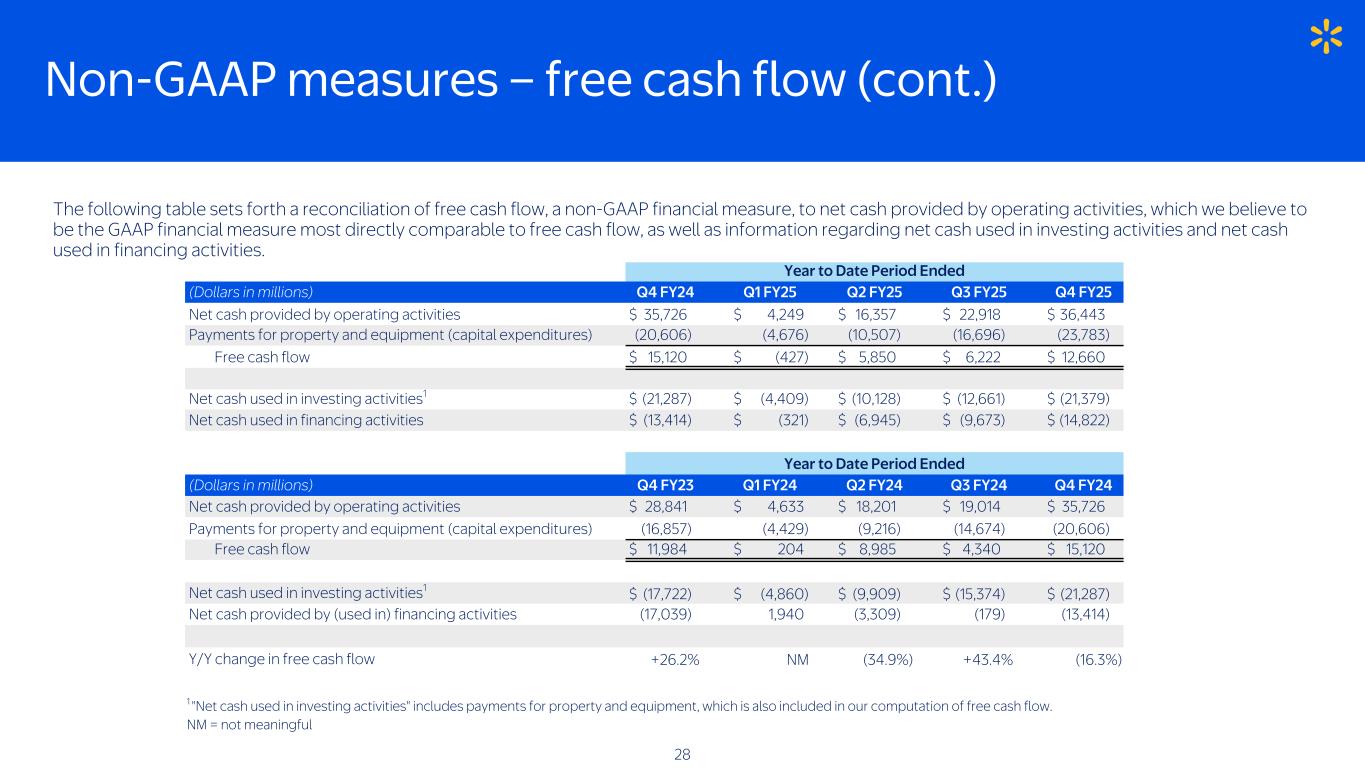
Non-GAAP measures – free cash flow (cont.) The following table sets forth a reconciliation of free cash flow, a non-GAAP financial measure, to net cash provided by operating activities, which we believe to be the GAAP financial measure most directly comparable to free cash flow, as well as information regarding net cash used in investing activities and net cash used in financing activities. Year to Date Period Ended (Dollars in millions) Q4 FY24 Q1 FY25 Q2 FY25 Q3 FY25 Q4 FY25 Net cash provided by operating activities $ 35,726 $ 4,249 $ 16,357 $ 22,918 $ 36,443 Payments for property and equipment (capital expenditures) (20,606) (4,676) (10,507) (16,696) (23,783) Free cash flow $ 15,120 $ (427) $ 5,850 $ 6,222 $ 12,660 Net cash used in investing activities1 $ (21,287) $ (4,409) $ (10,128) $ (12,661) $ (21,379) Net cash used in financing activities $ (13,414) $ (321) $ (6,945) $ (9,673) $ (14,822) Year to Date Period Ended (Dollars in millions) Q4 FY23 Q1 FY24 Q2 FY24 Q3 FY24 Q4 FY24 Net cash provided by operating activities $ 28,841 $ 4,633 $ 18,201 $ 19,014 $ 35,726 Payments for property and equipment (capital expenditures) (16,857) (4,429) (9,216) (14,674) (20,606) Free cash flow $ 11,984 $ 204 $ 8,985 $ 4,340 $ 15,120 Net cash used in investing activities1 $ (17,722) $ (4,860) $ (9,909) $ (15,374) $ (21,287) Net cash provided by (used in) financing activities (17,039) 1,940 (3,309) (179) (13,414) Y/Y change in free cash flow +26.2% NM (34.9%) +43.4% (16.3%) 1 "Net cash used in investing activities" includes payments for property and equipment, which is also included in our computation of free cash flow. NM = not meaningful 28
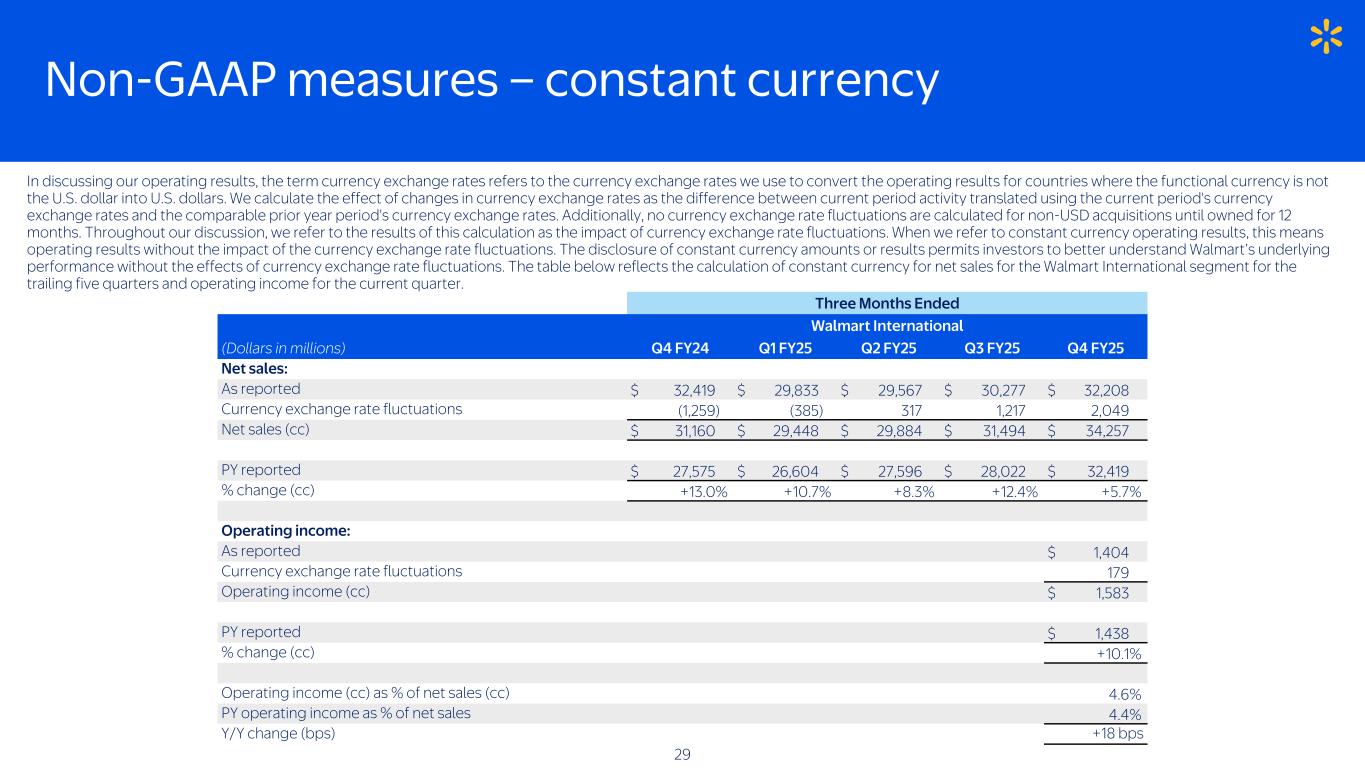
Non-GAAP measures – constant currency In discussing our operating results, the term currency exchange rates refers to the currency exchange rates we use to convert the operating results for countries where the functional currency is not the U.S. dollar into U.S. dollars. We calculate the effect of changes in currency exchange rates as the difference between current period activity translated using the current period's currency exchange rates and the comparable prior year period's currency exchange rates. Additionally, no currency exchange rate fluctuations are calculated for non-USD acquisitions until owned for 12 months. Throughout our discussion, we refer to the results of this calculation as the impact of currency exchange rate fluctuations. When we refer to constant currency operating results, this means operating results without the impact of the currency exchange rate fluctuations. The disclosure of constant currency amounts or results permits investors to better understand Walmart’s underlying performance without the effects of currency exchange rate fluctuations. The table below reflects the calculation of constant currency for net sales for the Walmart International segment for the trailing five quarters and operating income for the current quarter. Three Months Ended Walmart International (Dollars in millions) Q4 FY24 Q1 FY25 Q2 FY25 Q3 FY25 Q4 FY25 Net sales: As reported $ 32,419 $ 29,833 $ 29,567 $ 30,277 $ 32,208 Currency exchange rate fluctuations (1,259) (385) 317 1,217 2,049 Net sales (cc) $ 31,160 $ 29,448 $ 29,884 $ 31,494 $ 34,257 PY reported $ 27,575 $ 26,604 $ 27,596 $ 28,022 $ 32,419 % change (cc) +13.0% +10.7% +8.3% +12.4% +5.7% Operating income: As reported $ 1,404 Currency exchange rate fluctuations 179 Operating income (cc) $ 1,583 PY reported $ 1,438 % change (cc) +10.1% Operating income (cc) as % of net sales (cc) 4.6% PY operating income as % of net sales 4.4% Y/Y change (bps) +18 bps 29 1Q4 FY24 reflects reported results for comparison to current quarter growth in constant currency.
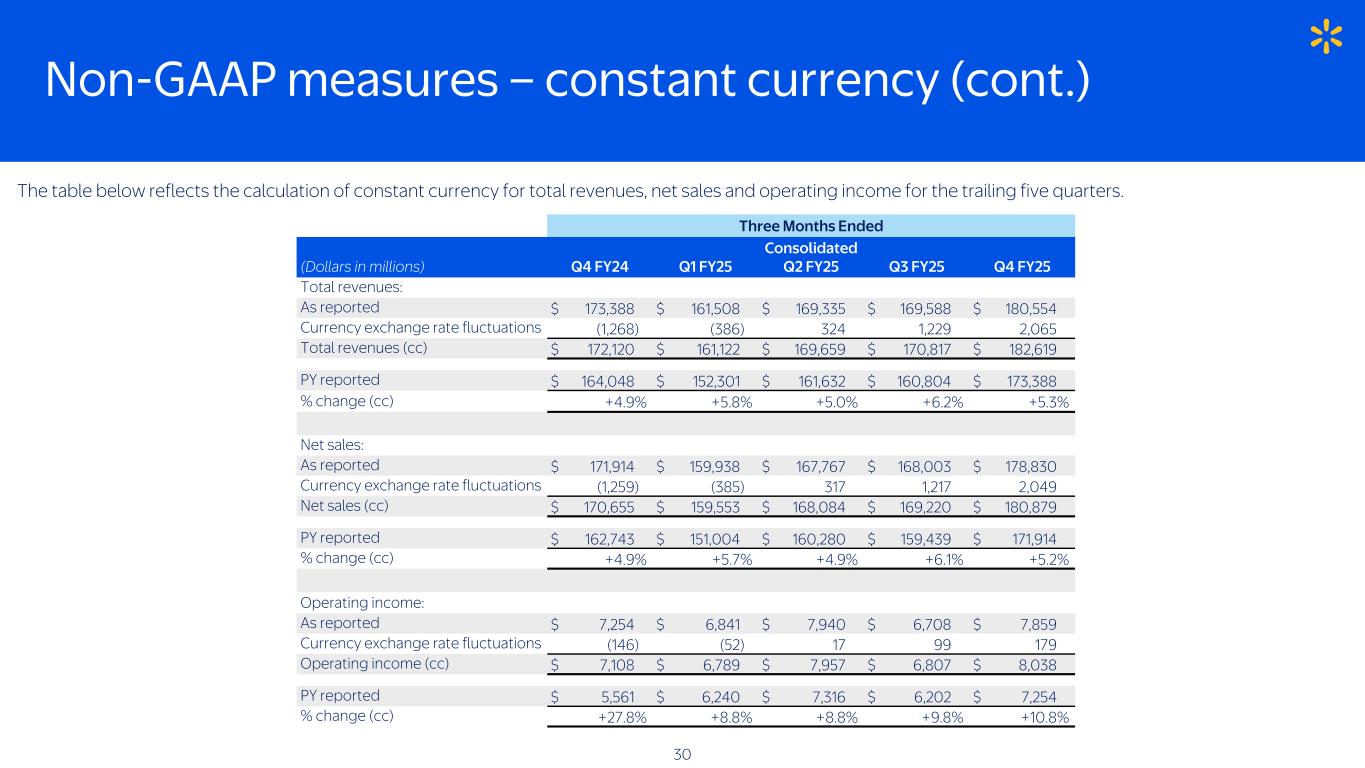
Non-GAAP measures – constant currency (cont.) Three Months Ended Consolidated (Dollars in millions) Q4 FY24 Q1 FY25 Q2 FY25 Q3 FY25 Q4 FY25 Total revenues: As reported $ 173,388 $ 161,508 $ 169,335 $ 169,588 $ 180,554 Currency exchange rate fluctuations (1,268) (386) 324 1,229 2,065 Total revenues (cc) $ 172,120 $ 161,122 $ 169,659 $ 170,817 $ 182,619 PY reported $ 164,048 $ 152,301 $ 161,632 $ 160,804 $ 173,388 % change (cc) +4.9% +5.8% +5.0% +6.2% +5.3% Net sales: As reported $ 171,914 $ 159,938 $ 167,767 $ 168,003 $ 178,830 Currency exchange rate fluctuations (1,259) (385) 317 1,217 2,049 Net sales (cc) $ 170,655 $ 159,553 $ 168,084 $ 169,220 $ 180,879 PY reported $ 162,743 $ 151,004 $ 160,280 $ 159,439 $ 171,914 % change (cc) +4.9% +5.7% +4.9% +6.1% +5.2% Operating income: As reported $ 7,254 $ 6,841 $ 7,940 $ 6,708 $ 7,859 Currency exchange rate fluctuations (146) (52) 17 99 179 Operating income (cc) $ 7,108 $ 6,789 $ 7,957 $ 6,807 $ 8,038 PY reported $ 5,561 $ 6,240 $ 7,316 $ 6,202 $ 7,254 % change (cc) +27.8% +8.8% +8.8% +9.8% +10.8% The table below reflects the calculation of constant currency for total revenues, net sales and operating income for the trailing five quarters. 30
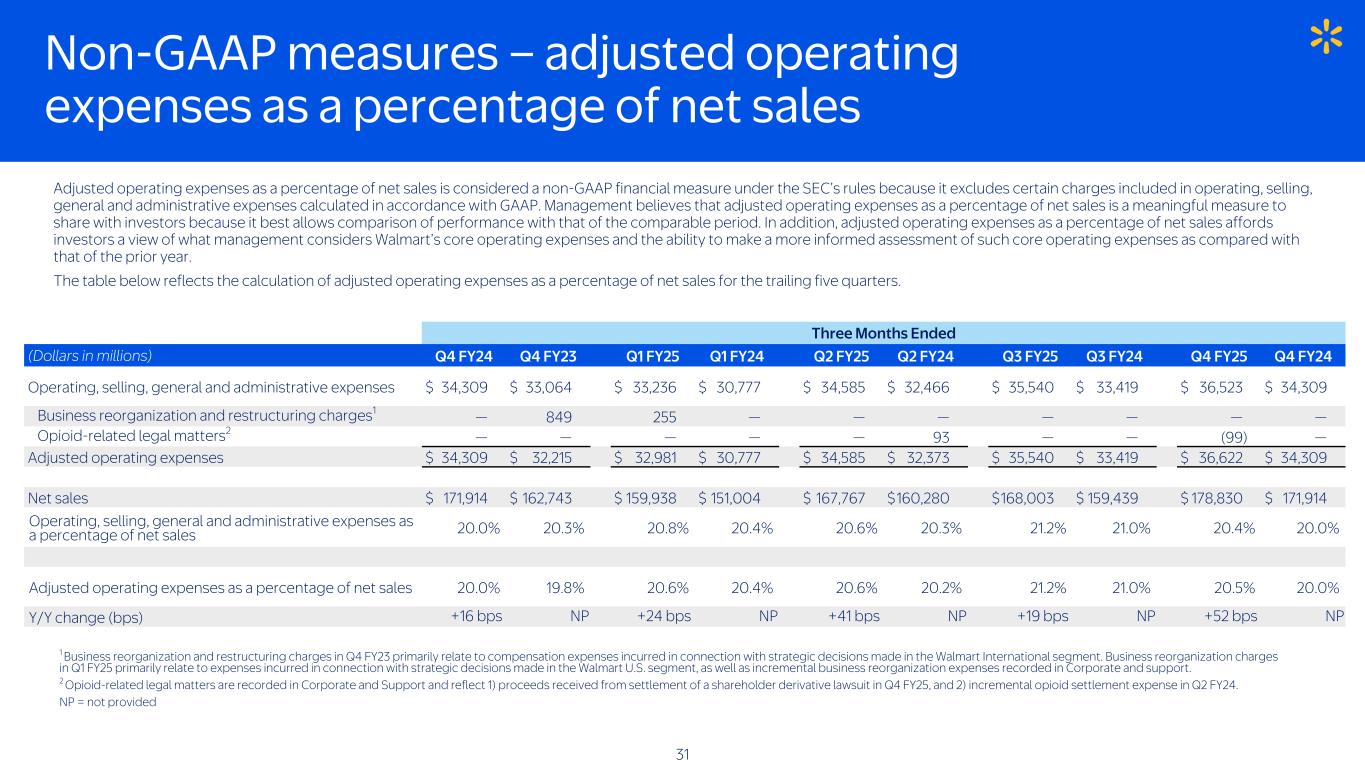
Non-GAAP measures – adjusted operating expenses as a percentage of net sales Three Months Ended (Dollars in millions) Q4 FY24 Q4 FY23 Q1 FY25 Q1 FY24 Q2 FY25 Q2 FY24 Q3 FY25 Q3 FY24 Q4 FY25 Q4 FY24 Operating, selling, general and administrative expenses $ 34,309 $ 33,064 $ 33,236 $ 30,777 $ 34,585 $ 32,466 $ 35,540 $ 33,419 $ 36,523 $ 34,309 Business reorganization and restructuring charges1 — 849 255 — — — — — — — Opioid-related legal matters2 — — — — — 93 — — (99) — Adjusted operating expenses $ 34,309 $ 32,215 $ 32,981 $ 30,777 $ 34,585 $ 32,373 $ 35,540 $ 33,419 $ 36,622 $ 34,309 Net sales $ 171,914 $ 162,743 $ 159,938 $ 151,004 $ 167,767 $ 160,280 $ 168,003 $ 159,439 $ 178,830 $ 171,914 Operating, selling, general and administrative expenses as a percentage of net sales 20.0% 20.3% 20.8% 20.4% 20.6% 20.3% 21.2% 21.0% 20.4% 20.0% Adjusted operating expenses as a percentage of net sales 20.0% 19.8% 20.6% 20.4% 20.6% 20.2% 21.2% 21.0% 20.5% 20.0% Y/Y change (bps) +16 bps NP +24 bps NP +41 bps NP +19 bps NP +52 bps NP 1 Business reorganization and restructuring charges in Q4 FY23 primarily relate to compensation expenses incurred in connection with strategic decisions made in the Walmart International segment. Business reorganization charges in Q1 FY25 primarily relate to expenses incurred in connection with strategic decisions made in the Walmart U.S. segment, as well as incremental business reorganization expenses recorded in Corporate and support. 2 Opioid-related legal matters are recorded in Corporate and Support and reflect 1) proceeds received from settlement of a shareholder derivative lawsuit in Q4 FY25, and 2) incremental opioid settlement expense in Q2 FY24. NP = not provided Adjusted operating expenses as a percentage of net sales is considered a non-GAAP financial measure under the SEC’s rules because it excludes certain charges included in operating, selling, general and administrative expenses calculated in accordance with GAAP. Management believes that adjusted operating expenses as a percentage of net sales is a meaningful measure to share with investors because it best allows comparison of performance with that of the comparable period. In addition, adjusted operating expenses as a percentage of net sales affords investors a view of what management considers Walmart’s core operating expenses and the ability to make a more informed assessment of such core operating expenses as compared with that of the prior year. The table below reflects the calculation of adjusted operating expenses as a percentage of net sales for the trailing five quarters. 31
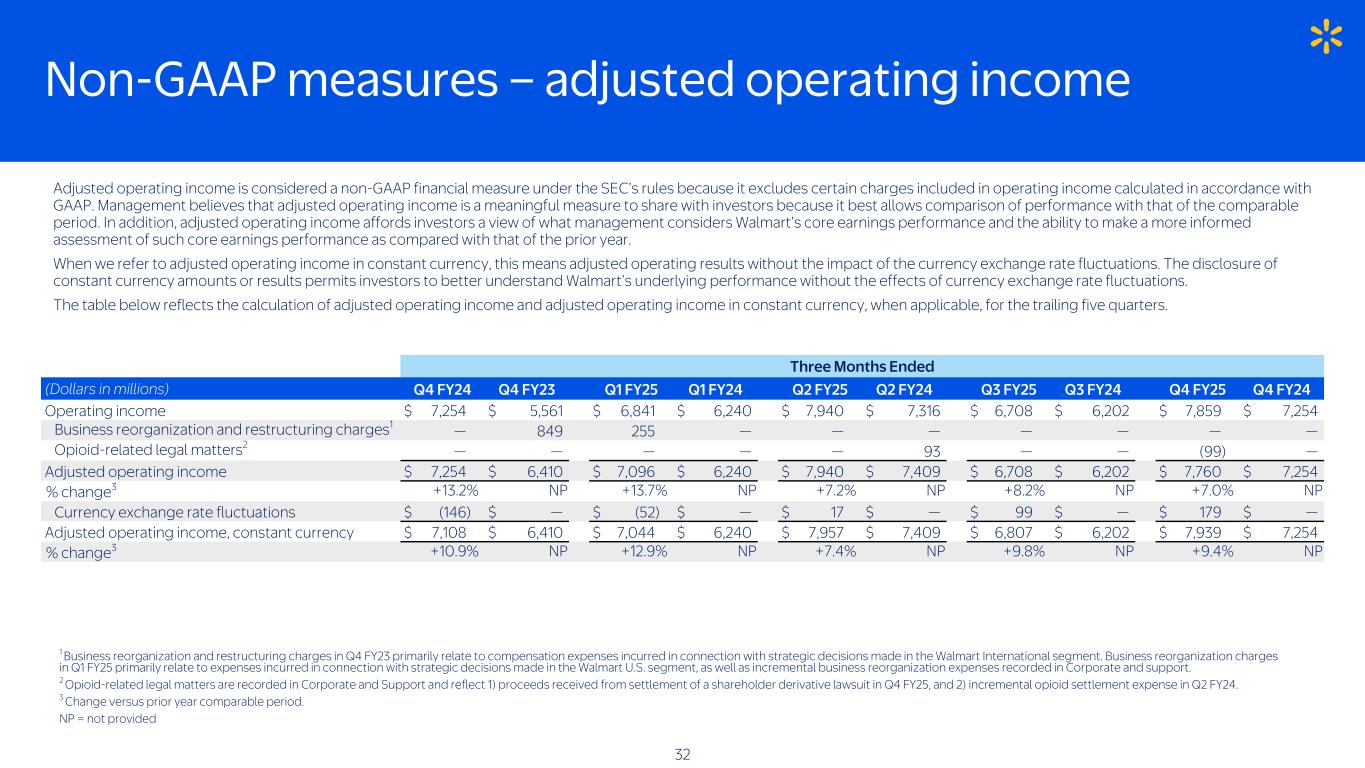
Non-GAAP measures – adjusted operating income Three Months Ended (Dollars in millions) Q4 FY24 Q4 FY23 Q1 FY25 Q1 FY24 Q2 FY25 Q2 FY24 Q3 FY25 Q3 FY24 Q4 FY25 Q4 FY24 Operating income $ 7,254 $ 5,561 $ 6,841 $ 6,240 $ 7,940 $ 7,316 $ 6,708 $ 6,202 $ 7,859 $ 7,254 Business reorganization and restructuring charges1 — 849 255 — — — — — — — Opioid-related legal matters2 — — — — — 93 — — (99) — Adjusted operating income $ 7,254 $ 6,410 $ 7,096 $ 6,240 $ 7,940 $ 7,409 $ 6,708 $ 6,202 $ 7,760 $ 7,254 % change3 +13.2% NP +13.7% NP +7.2% NP +8.2% NP +7.0% NP Currency exchange rate fluctuations $ (146) $ — $ (52) $ — $ 17 $ — $ 99 $ — $ 179 $ — Adjusted operating income, constant currency $ 7,108 $ 6,410 $ 7,044 $ 6,240 $ 7,957 $ 7,409 $ 6,807 $ 6,202 $ 7,939 $ 7,254 % change3 +10.9% NP +12.9% NP +7.4% NP +9.8% NP +9.4% NP Adjusted operating income is considered a non-GAAP financial measure under the SEC’s rules because it excludes certain charges included in operating income calculated in accordance with GAAP. Management believes that adjusted operating income is a meaningful measure to share with investors because it best allows comparison of performance with that of the comparable period. In addition, adjusted operating income affords investors a view of what management considers Walmart’s core earnings performance and the ability to make a more informed assessment of such core earnings performance as compared with that of the prior year. When we refer to adjusted operating income in constant currency, this means adjusted operating results without the impact of the currency exchange rate fluctuations. The disclosure of constant currency amounts or results permits investors to better understand Walmart’s underlying performance without the effects of currency exchange rate fluctuations. The table below reflects the calculation of adjusted operating income and adjusted operating income in constant currency, when applicable, for the trailing five quarters. 1 Business reorganization and restructuring charges in Q4 FY23 primarily relate to compensation expenses incurred in connection with strategic decisions made in the Walmart International segment. Business reorganization charges in Q1 FY25 primarily relate to expenses incurred in connection with strategic decisions made in the Walmart U.S. segment, as well as incremental business reorganization expenses recorded in Corporate and support. 2 Opioid-related legal matters are recorded in Corporate and Support and reflect 1) proceeds received from settlement of a shareholder derivative lawsuit in Q4 FY25, and 2) incremental opioid settlement expense in Q2 FY24. 3 Change versus prior year comparable period. NP = not provided 32
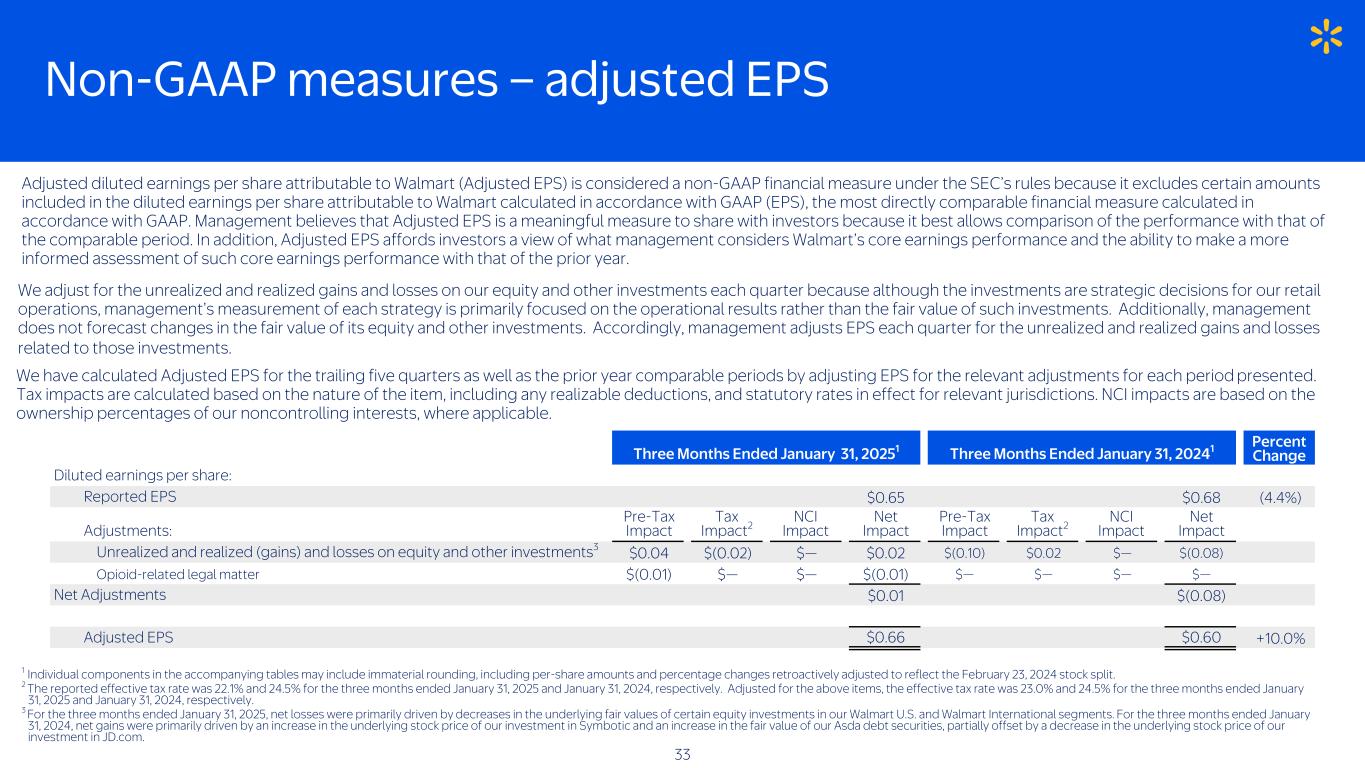
Non-GAAP measures – adjusted EPS Adjusted diluted earnings per share attributable to Walmart (Adjusted EPS) is considered a non-GAAP financial measure under the SEC’s rules because it excludes certain amounts included in the diluted earnings per share attributable to Walmart calculated in accordance with GAAP (EPS), the most directly comparable financial measure calculated in accordance with GAAP. Management believes that Adjusted EPS is a meaningful measure to share with investors because it best allows comparison of the performance with that of the comparable period. In addition, Adjusted EPS affords investors a view of what management considers Walmart’s core earnings performance and the ability to make a more informed assessment of such core earnings performance with that of the prior year. We adjust for the unrealized and realized gains and losses on our equity and other investments each quarter because although the investments are strategic decisions for our retail operations, management’s measurement of each strategy is primarily focused on the operational results rather than the fair value of such investments. Additionally, management does not forecast changes in the fair value of its equity and other investments. Accordingly, management adjusts EPS each quarter for the unrealized and realized gains and losses related to those investments. We have calculated Adjusted EPS for the trailing five quarters as well as the prior year comparable periods by adjusting EPS for the relevant adjustments for each period presented. Tax impacts are calculated based on the nature of the item, including any realizable deductions, and statutory rates in effect for relevant jurisdictions. NCI impacts are based on the ownership percentages of our noncontrolling interests, where applicable. Three Months Ended January 31, 20251 Three Months Ended January 31, 20241 Percent Change Diluted earnings per share: Reported EPS $0.65 $0.68 (4.4%) Adjustments: Pre-Tax Impact Tax Impact2 NCI Impact Net Impact Pre-Tax Impact Tax Impact2 NCI Impact Net Impact Unrealized and realized (gains) and losses on equity and other investments3 $0.04 $(0.02) $— $0.02 $(0.10) $0.02 $— $(0.08) Opioid-related legal matter $(0.01) $— $— $(0.01) $— $— $— $— Net Adjustments $0.01 $(0.08) Adjusted EPS $0.66 $0.60 +10.0% 1 Individual components in the accompanying tables may include immaterial rounding, including per-share amounts and percentage changes retroactively adjusted to reflect the February 23, 2024 stock split. 2 The reported effective tax rate was 22.1% and 24.5% for the three months ended January 31, 2025 and January 31, 2024, respectively. Adjusted for the above items, the effective tax rate was 23.0% and 24.5% for the three months ended January 31, 2025 and January 31, 2024, respectively. 3 For the three months ended January 31, 2025, net losses were primarily driven by decreases in the underlying fair values of certain equity investments in our Walmart U.S. and Walmart International segments. For the three months ended January 31, 2024, net gains were primarily driven by an increase in the underlying stock price of our investment in Symbotic and an increase in the fair value of our Asda debt securities, partially offset by a decrease in the underlying stock price of our investment in JD.com. 33
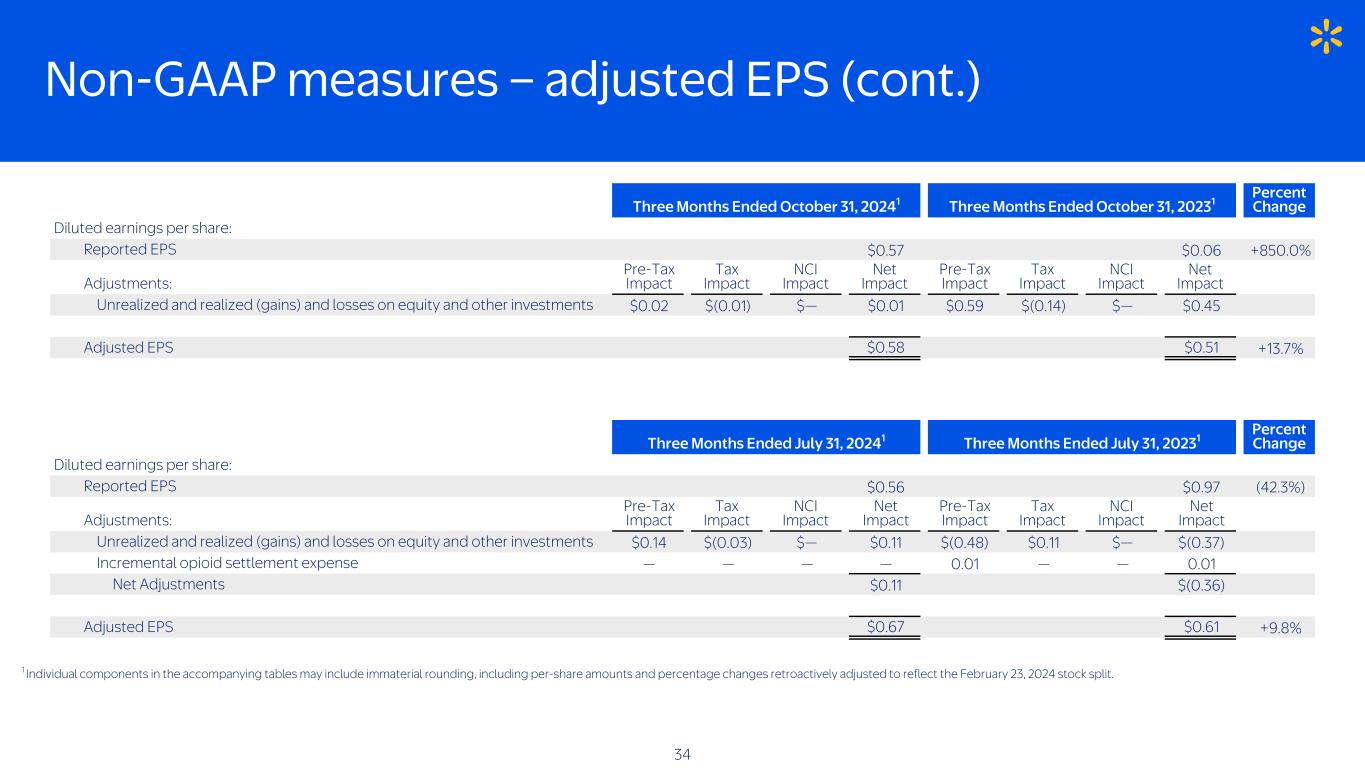
Non-GAAP measures – adjusted EPS (cont.) Three Months Ended October 31, 20241 Three Months Ended October 31, 20231 Percent Change Diluted earnings per share: Reported EPS $0.57 $0.06 +850.0% Adjustments: Pre-Tax Impact Tax Impact NCI Impact Net Impact Pre-Tax Impact Tax Impact NCI Impact Net Impact Unrealized and realized (gains) and losses on equity and other investments $0.02 $(0.01) $— $0.01 $0.59 $(0.14) $— $0.45 Adjusted EPS $0.58 $0.51 +13.7% Three Months Ended July 31, 20241 Three Months Ended July 31, 20231 Percent Change Diluted earnings per share: Reported EPS $0.56 $0.97 (42.3%) Adjustments: Pre-Tax Impact Tax Impact NCI Impact Net Impact Pre-Tax Impact Tax Impact NCI Impact Net Impact Unrealized and realized (gains) and losses on equity and other investments $0.14 $(0.03) $— $0.11 $(0.48) $0.11 $— $(0.37) Incremental opioid settlement expense — — — — 0.01 — — 0.01 Net Adjustments $0.11 $(0.36) Adjusted EPS $0.67 $0.61 +9.8% 1 Individual components in the accompanying tables may include immaterial rounding, including per-share amounts and percentage changes retroactively adjusted to reflect the February 23, 2024 stock split. 34
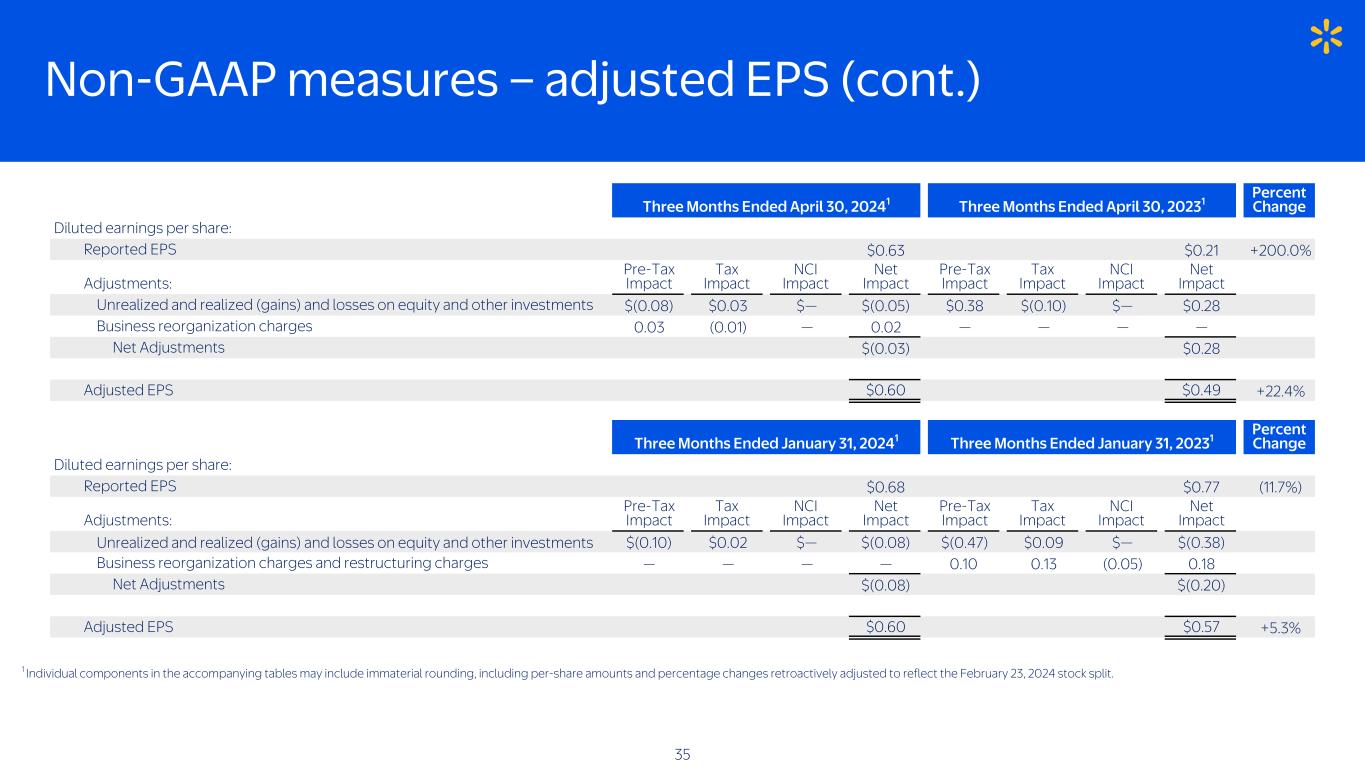
Non-GAAP measures – adjusted EPS (cont.) Three Months Ended January 31, 20241 Three Months Ended January 31, 20231 Percent Change Diluted earnings per share: Reported EPS $0.68 $0.77 (11.7%) Adjustments: Pre-Tax Impact Tax Impact NCI Impact Net Impact Pre-Tax Impact Tax Impact NCI Impact Net Impact Unrealized and realized (gains) and losses on equity and other investments $(0.10) $0.02 $— $(0.08) $(0.47) $0.09 $— $(0.38) Business reorganization charges and restructuring charges — — — — 0.10 0.13 (0.05) 0.18 Net Adjustments $(0.08) $(0.20) Adjusted EPS $0.60 $0.57 +5.3% Three Months Ended April 30, 20241 Three Months Ended April 30, 20231 Percent Change Diluted earnings per share: Reported EPS $0.63 $0.21 +200.0% Adjustments: Pre-Tax Impact Tax Impact NCI Impact Net Impact Pre-Tax Impact Tax Impact NCI Impact Net Impact Unrealized and realized (gains) and losses on equity and other investments $(0.08) $0.03 $— $(0.05) $0.38 $(0.10) $— $0.28 Business reorganization charges 0.03 (0.01) — 0.02 — — — — Net Adjustments $(0.03) $0.28 Adjusted EPS $0.60 $0.49 +22.4% 1 Individual components in the accompanying tables may include immaterial rounding, including per-share amounts and percentage changes retroactively adjusted to reflect the February 23, 2024 stock split. 35
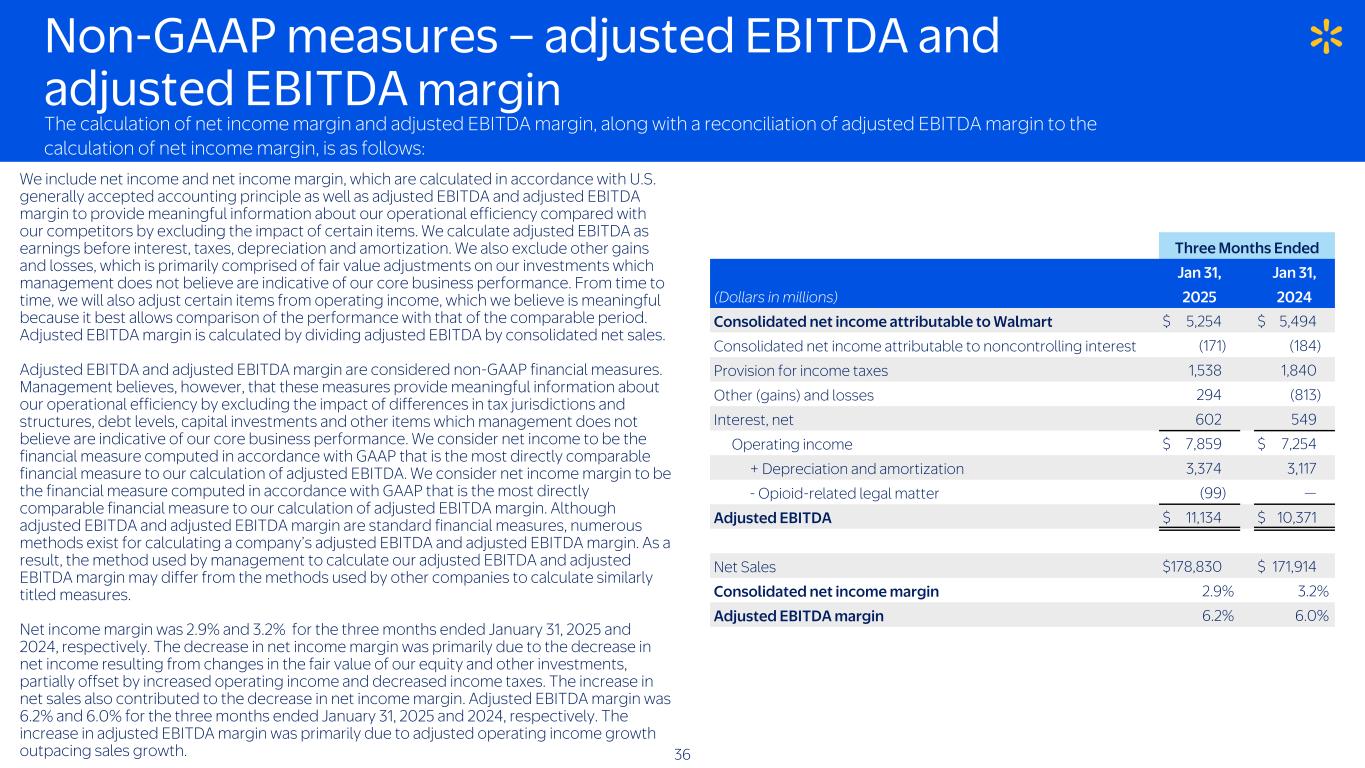
Non-GAAP measures – adjusted EBITDA and adjusted EBITDA margin The calculation of net income margin and adjusted EBITDA margin, along with a reconciliation of adjusted EBITDA margin to the calculation of net income margin, is as follows: Three Months Ended Jan 31, Jan 31, (Dollars in millions) 2025 2024 Consolidated net income attributable to Walmart $ 5,254 $ 5,494 Consolidated net income attributable to noncontrolling interest (171) (184) Provision for income taxes 1,538 1,840 Other (gains) and losses 294 (813) Interest, net 602 549 Operating income $ 7,859 $ 7,254 + Depreciation and amortization 3,374 3,117 - Opioid-related legal matter (99) — Adjusted EBITDA $ 11,134 $ 10,371 Net Sales $ 178,830 $ 171,914 Consolidated net income margin 2.9% 3.2% Adjusted EBITDA margin 6.2% 6.0% We include net income and net income margin, which are calculated in accordance with U.S. generally accepted accounting principle as well as adjusted EBITDA and adjusted EBITDA margin to provide meaningful information about our operational efficiency compared with our competitors by excluding the impact of certain items. We calculate adjusted EBITDA as earnings before interest, taxes, depreciation and amortization. We also exclude other gains and losses, which is primarily comprised of fair value adjustments on our investments which management does not believe are indicative of our core business performance. From time to time, we will also adjust certain items from operating income, which we believe is meaningful because it best allows comparison of the performance with that of the comparable period. Adjusted EBITDA margin is calculated by dividing adjusted EBITDA by consolidated net sales. Adjusted EBITDA and adjusted EBITDA margin are considered non-GAAP financial measures. Management believes, however, that these measures provide meaningful information about our operational efficiency by excluding the impact of differences in tax jurisdictions and structures, debt levels, capital investments and other items which management does not believe are indicative of our core business performance. We consider net income to be the financial measure computed in accordance with GAAP that is the most directly comparable financial measure to our calculation of adjusted EBITDA. We consider net income margin to be the financial measure computed in accordance with GAAP that is the most directly comparable financial measure to our calculation of adjusted EBITDA margin. Although adjusted EBITDA and adjusted EBITDA margin are standard financial measures, numerous methods exist for calculating a company’s adjusted EBITDA and adjusted EBITDA margin. As a result, the method used by management to calculate our adjusted EBITDA and adjusted EBITDA margin may differ from the methods used by other companies to calculate similarly titled measures. Net income margin was 2.9% and 3.2% for the three months ended January 31, 2025 and 2024, respectively. The decrease in net income margin was primarily due to the decrease in net income resulting from changes in the fair value of our equity and other investments, partially offset by increased operating income and decreased income taxes. The increase in net sales also contributed to the decrease in net income margin. Adjusted EBITDA margin was 6.2% and 6.0% for the three months ended January 31, 2025 and 2024, respectively. The increase in adjusted EBITDA margin was primarily due to adjusted operating income growth outpacing sales growth. 36